Reserve Bank Bulletin – November 1997 Semi-Annual Statement on Monetary Policy
Download the complete Statement 336KB
Introduction
During 1997, the Australian economy has been gradually emerging from a mild slowdown which began during 1995 and continued through 1996. At its low point, in the second half of 1996, annualised growth in real GDP fell to around 2 per cent, according to the national income accounts. By the first half of 1997, growth increased to an annual pace of nearly 4 per cent.
As is usually the case with such episodes, several cyclical dynamics were at work. The first was the working out of a mild inventory cycle, which now appears largely to have run its course. A second factor was that monetary policy began to ease in mid 1996 in recognition that the outlook for inflation had improved. Inflation had begun to decline to rates much more consistent with the Bank's medium-term inflation target, having been slightly above target for a year or so previously. This reduction in inflation was in turn a result both of the period of more subdued growth, and of the appreciation in the exchange rate during early 1996. It was accompanied by a further structural decline in inflation expectations in various parts of the community, resulting in a change in behaviour which opened up the scope for monetary policy to adopt a more expansionary stance. As a result, the three reductions in official interest rates during 1996 have been followed by two further declines since the first Semi-Annual Statement on Monetary Policy was issued in May 1997. These changes are having an impact on interest sensitive areas of domestic demand in the economy, which are now contributing to the increase in growth, and there are some encouraging signs in the labour market. In the period ahead, subject to some caveats about export markets (dealt with below) it is reasonable to anticipate that this will continue.
Until October, financial markets were reasonably steady, and generally in an optimistic frame of mind. Interest rates paid and charged by financial intermediaries, and yields in money and capital markets, moved to low levels both by historical and international standards, and share prices rose to new highs. The favourable conditions in Australian markets were supported by developments in the main markets overseas, which were mostly buoyant as fears of a pick-up in inflation receded. The instability in financial markets in parts of Asia, which affected first Thailand, and then subsequently spread to Indonesia, Malaysia and the Philippines, to that point had not generally affected Australian or global markets very much. Domestic capital markets remained bullish, and while the exchange rate of the Australian dollar eased against the US dollar, this was due mainly to the strength of the latter.
The situation has changed, however, in recent weeks. The trigger was the spread of currency pressures more widely in Asia, particularly to Hong Kong. They quickly spilled over into share prices there, subsequently setting off a period of great volatility in global share markets. The size of the impact of the Asian problems on global markets was something new, but it was most likely due to the fact that markets in some major countries had already reached very high levels by historical standards. As share markets fell, funds flowed into government bonds. Australian markets reflected these global trends, the impact here being, if anything, larger than in most other industrial countries, reflecting our close links to Asia. In addition, we have experienced a net fall in the exchange rate of the Australian dollar over the past fortnight.
The outlook for Asia is the key uncertainty in assessing prospects for the Australian economy over the next year or two. Recent events are likely to result in a marked slowing in growth in some of Australia's Asian trading partners, with consequent loss of export sales and reduced income flows from foreign operations of Australian firms. The extent and duration of this is difficult to predict with any degree of confidence, because asset price falls and subsequent banking problems are a central part of the unfolding events. Much will depend on how successful the various countries are at confronting and dealing with these and other problems, and how quickly the confidence of financial markets can be regained. Assistance by the International Monetary Fund to Thailand and Indonesia should help this process, and provide a basis for recovery. Australia's participation in both of these programs has helped in quickly formulating these regional support packages. Developments in North America, where growth remains strong, and Europe, where it is picking up, may also provide some partial offset to the pessimistic news from our north.
Despite some precautionary rises in interest rates in Europe and North America, there are few signs of inflationary pressures around the world, and the Australian economy is sharing in this good inflation performance. The forces which have acted to bring inflation down to unusually low levels over the recent period are, however, likely to wane over the coming year to 18 months. Within that period, underlying inflation is likely to edge up to be a little above 2 per cent, and remain consistent with the target thereafter. While this remains the case, monetary policy will be able to maintain its present stance, which is moderately encouraging to growth.
The events in Asia are still unfolding, and further instability in financial markets cannot be ruled out. The subsequent efforts of Asian countries to resume growth via exports may increase international competition and further dampen prices in world markets. This environment underscores the need for costs in Australia to remain tightly controlled. It is disappointing that earlier signs of slowing in growth of Australian labour costs do not appear to have continued, judging from the most recent data. While current rates of growth of wages and salaries are still consistent with achieving the inflation target, faster reductions in unemployment would be achievable were wages growth to be slower.
Developments in East Asia
Since the 1960s, east Asia has recorded exceptional rates of economic growth. For the most part, this has been trade-oriented growth, underpinned by generally prudent macroeconomic policies. Fiscal policies have been conservative, inflation has been moderate, and domestic saving has been high. The very strong rates of investment in a number of Asian countries outstripped even the high domestic saving rates, with substantial current account deficits providing the extra resources for investment. The inflow of foreign capital which financed these deficits stepped up in the 1990s, reflecting changing perceptions in world capital markets about these ‘emerging economies’. The flows were facilitated by the financial deregulation and institutional development occurring in these countries. Encouraged by high rates of expected return characteristic of rapidly growing dynamic economies and the shift of production capacity from high-cost countries such as Japan, these flows in some instances amounted to 10 per cent of GDP over a number of years (Table 1).
| GDP | Net private capital inflows(a) |
Domestic credit |
||
|---|---|---|---|---|
| Average annual growth |
Per cent of GDP | Per cent of GDP |
||
| 1990–1996 | 1990–1996 | 1990 | 1996 | |
| Indonesia | 7.2 | 4.0 | 49 | 55 |
| Malaysia | 8.7 | 10.4 | 78 | 103 |
| Philippines | 2.8 | 6.1 | 23 | 66 |
| Thailand | 8.6 | 10.6 | 70 | 99 |
| Singapore | 8.4 | −1.4 | 61 | 65 |
| China | 10.5 | 3.2 | 90 | 95 |
| Taiwan | 6.3 | −3.0 | 104 | 165 |
| Hong Kong | 5.1 | n.a. | 132(b) | 156 |
| South Korea | 7.7 | 3.2 | 57 | 65 |
|
(a) Average annual flows Sources: IMF International Financial Statistics, national governments |
||||
The combination of rapid growth and large capital inflows was reflected in rapid credit expansion, an over-extension of corporate balance sheets, rising equity and property prices, over-investment in particular sectors and some lowering of the quality of investment undertaken. At the same time, the rapid growth of the financial sector outpaced the development of prudential regulation and left the financial sectors of these economies vulnerable. The heavy recourse to foreign financing was often of a short-term nature, with the borrower bearing the foreign exchange risk in many cases.
This combination of circumstances gave these economies an outstanding record of growth, but also left them vulnerable to changes in sentiment, and with financial sectors which lacked resilience when confidence deteriorated. An initially modest reassessment of credit risk and exchange rate relativities has been enough to spark off substantial exchange rate changes and a process of widespread financial strains which seem likely to cut growth rates in the ‘ASEAN-4’ – Thailand, Malaysia, Indonesia and the Philippines – for the immediate future.
The trigger was the emergence of exchange rate pressures, beginning in Thailand. The practice of keeping exchange rates reasonably constant against the US dollar meant that several Asian countries had suffered a fall in competitiveness in the past couple of years (Graph 1) as the US dollar rose strongly against most other currencies, particularly the yen. The impact of this deterioration in competitiveness on the east Asian economies was exacerbated in 1996 by a world-wide slump in the semi-conductor market – a market in which east Asia had increasingly specialised. Thus by late 1996 and early 1997, downward pressure was starting to be felt on the exchange rates of the most exposed Asian countries and capital inflow was drying up, or in some cases turning to outflow. The situation was not helped by the increasing recognition that difficulties were being experienced by banks and other financial intermediaries, particularly in Thailand.

While the Thai authorities managed for a time to resist these pressures, they were eventually forced to float the exchange rate in early July. The baht exchange rate quickly fell by about 15 per cent. This intensified pressures on other countries and, in the weeks that followed, the Indonesian rupiah and Philippine peso were also floated. The Malaysian ringgit was not formally floated, but was managed much more flexibly and its movements broadly paralleled those of the other three currencies (Graph 2). By end August, the Thai baht had depreciated by about 25 per cent from its pre-May level, the Indonesian and Philippine currencies were down by around 20 per cent, and the Malaysian ringgit had fallen by about 15 per cent.
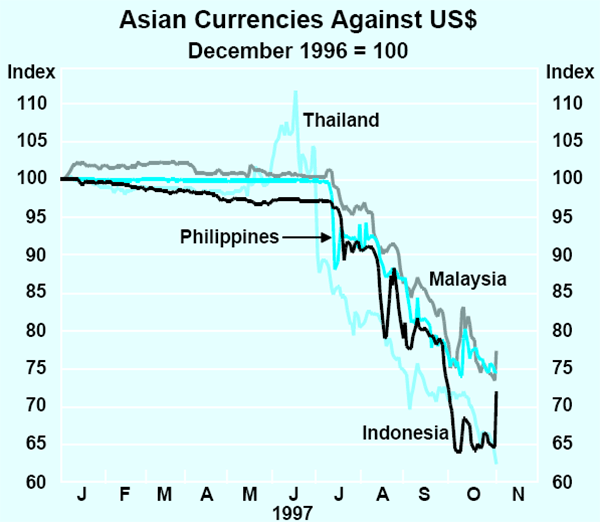
This initial adjustment of exchange rates was followed by a brief period of stability in September, helped by the announcement of the IMF's rescue package for Thailand. This involved a US$17 billion assistance package, encompassing IMF resources and bilateral assistance from other countries in the region (including Australia). As part of the package, Thailand agreed to implement economic reforms, including fiscal measures, a reduction in reliance on foreign capital inflow and further restructuring of a number of ailing financial institutions.
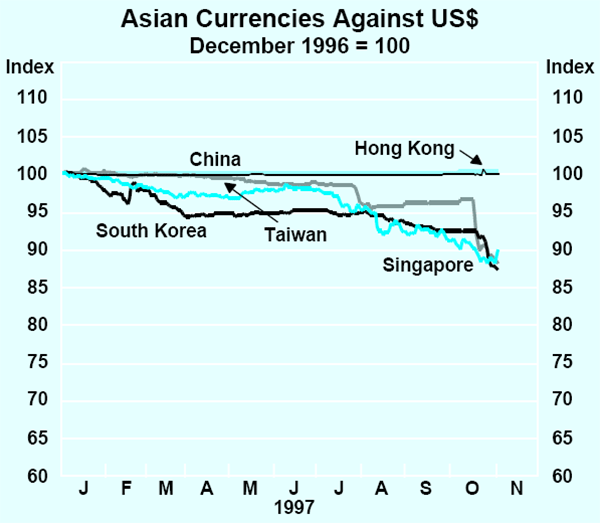
By late September, however, exchange rates of the four currencies in question began to depreciate again. One factor behind the resumption of exchange pressures was market concerns about some of the responses by governments to the emerging difficulties. Markets also focused on the possible inter-relationships between the falls in exchange rates, capital flows, falls in property prices and the health of the financial systems concerned. The general increase in interest rates in the region, in order to support exchange rates, was seen as adding to the difficulties in asset markets. In some east Asian countries, the likelihood that the exchange rate falls would add to strains in financial systems was heightened by the high levels of foreign currency borrowings by residents. Exchange rates in these four countries have now fallen by between 25 and 40 per cent since mid 1997.
Until late October, the pressures were confined largely to the four ASEAN economies but they then spread to other countries, including Hong Kong. The stability of the exchange rate in Hong Kong is a political as well as an economic issue, as Hong Kong has promoted the fixed exchange rate to the US dollar as the corner-stone of stability and an essential part of the ‘one country-two systems’ policy. Markets assessed that the authorities in Hong Kong would resist any change in the exchange rate despite the loss of competitiveness, and that the inevitable rise in interest rates would have adverse implications for economic activity and asset markets. On the day of most intense pressure in October, the Hong Kong authorities pushed overnight interest rates to 300 per cent, and the share market fell by over 10 per cent. Given the importance of Hong Kong in world financial markets, the impact quickly spilled outside the region; sharp falls were experienced in equity prices around the globe and there was a ‘flight to quality’ into government bonds.
Implications for Australian and world markets
From the float of the Thai baht on 2 July until mid October, the problems in Asia had no significant impact on Australian markets. While the Australian dollar has been falling against the US dollar for much of 1997 (Graph 4), most of the explanation for this was the strength of the US currency, although narrowing interest differentials and lacklustre commodity prices also played a part.
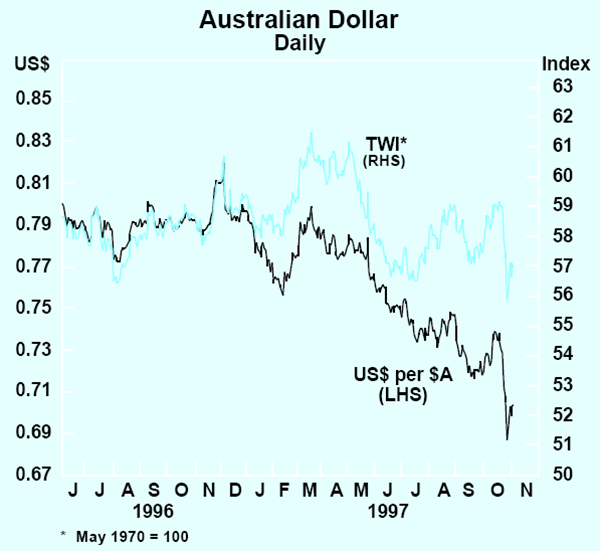
However, when the problems in Asia spread in late October, Australian markets were caught up in the ensuing global turbulence. Events in Asia seem to have had three main effects on Australian markets. First, they caused a fall in the exchange rate. The spreading of the Asian instability to Hong Kong was responsible for the fall of the Australian dollar from about US 74 cents to US 71 cents. It probably also contributed to the exaggerated response to the fall in the price of gold at the end of October; the Australian dollar fell from US 70.5 cents to US 68.5 cents after the Swiss made further announcements about possible changes in the management of gold reserves. Speculators who had been selling the Australian dollar earlier on Asian concerns, were reinforced in their actions by the fall in the gold price. While the Australian dollar staged some recovery towards the end of October as share markets and gold prices showed signs of stabilising, it has nonetheless fallen by 11 per cent against the US dollar since the start of 1997. In trade-weighted terms, the Australian dollar has held up better, and is not far from its long-run average.
The second impact of the Asian crisis has been on our share market. Australian share prices fell sharply in October. The fall was part of a world-wide reaction on share markets (Table 2), though the Australian fall was a little larger than the average of other industrial countries. This greater impact is a reflection of our close economic links with Asia. All sectors of the Australian market were affected by the volatility in October, though resource companies, with their large exposure to Asian markets, and which had underperformed in the earlier rising market, fared the worst from the market fall.
| Industrial countries | Asia | ||||
|---|---|---|---|---|---|
| Since end September 1997 |
1997 to date |
Since end September 1997 |
1997 to date |
||
| United States | −6 | 15 | China | 8 | 30 |
| Japan | −8 | −15 | Hong Kong | −25 | −16 |
| Germany | −11 | 29 | Indonesia | −8 | −21 |
| Canada | −3 | 15 | South Korea | −21 | −21 |
| Italy | −9 | 38 | Malaysia | −12 | −42 |
| France | −9 | 18 | Philippines | −11 | −42 |
| United Kingdom | −8 | 18 | Singapore | −13 | −23 |
| New Zealand | −7 | 2 | Taiwan | −12 | 10 |
| Australia | −10 | 3 | Thailand | −18 | −46 |
This is probably the first time that share market falls in Asia have had a significant impact on industrial countries' share prices. In large part this was because many market participants felt that a correction in global share markets was overdue. Signs had been apparent before the fallout from Asia of increasing nervousness in share markets. Share prices in most countries reached a peak in late July, when they seemed to lose upward momentum, as spirits were dampened by some downward revisions to profit forecasts in the US. In this climate, a shock in any major financial centre, either in Asia or elsewhere, had the potential to trigger substantial corrections in prices in other markets, which were widely recognised as overheated.
The third area to be affected was the bond market. Here, the immediate impact was positive, reflecting a ‘flight to quality’ by share investors seeking stability of income flows and greater certainty about capital values and credit standing.
Prior to the escalation of the Asian crisis, world bond markets had begun to show signs of nervousness, and bond yields had begun to rise. This move started when Federal Reserve Chairman Greenspan expressed concerns about the potential for US inflation to rise, given the prevailing tightness of labour markets there. Financial markets saw this as a sign that the US was moving closer to the point of tightening monetary policy again. The rise in yields was reinforced by the tightening of monetary policy by a number of European central banks in mid October.
The move up in world bond yields was reversed when the Hong Kong stock market fell sharply on 22 October, as investors sought safe haven in bonds. From 6.2 per cent in mid October, US yields fell back to around 5.8 per cent. Here in Australia, yields on 10-year bonds fell from a high of almost 6.5 per cent, reached after the publication of disappointing wage data on 23 October, to around 6 per cent at present (Graph 5). As in the US market, the key factor underlying the fall in local bond yields was the switch out of equities.
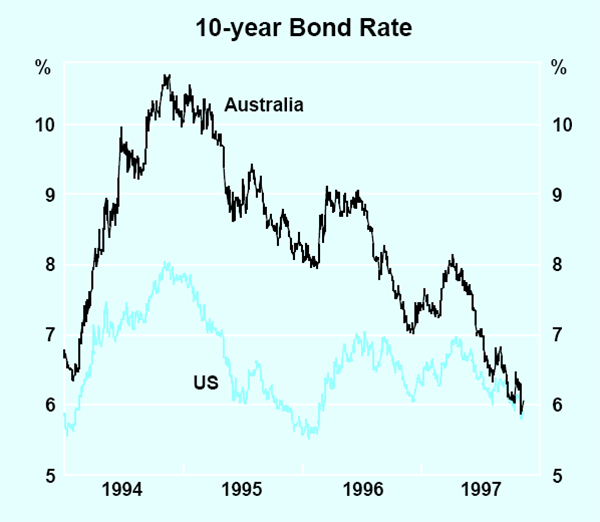
The recent gyrations should not distract attention from some favourable longer-term trends in interest rates, both in Australia and abroad. While the decline in bond yields in late October reflects ‘safe-haven’ considerations that might not be sustained indefinitely, bond yields in Australia had already fallen to their lowest levels since financial deregulation in the early 1980s, which allowed yields to be set freely by the market. The fall in yields has resulted in a further sharp narrowing of the premium over US securities which investors used to require (Box A). While a number of influences, including the improvement in the fiscal position of the Government, contributed to this reduction, the primary factor is the low level of inflation. Dormant inflationary pressures represent highly favourable conditions for bond markets.
Broader implications of the Asian financial instability
The exact extent of the financial difficulties faced in a number of Asian economies remains extremely difficult to judge. Reliable information is scarce, and to a large extent questions of asset valuation are inherently subjective and based on forecasts of future prices. It is clear nonetheless that several countries in the region face a period of adjustment to lower asset values and rebuilding of corporate and bank balance sheets.
The full resolution of problems in banking systems will take some time. Experience in other countries which have had such difficulties indicates that the speed with which these problems are identified, and arrangements set in place for resolving them, are critical in determining how quickly the broader economy can be returned to better health and the confidence of domestic and international financial markets regained. However, even with a good policy response, a period of very weak economic growth can be expected for these countries. During that time, their imports will be depressed, with adverse repercussions for countries exporting into the area.
In the meantime, export sectors of a number of countries will receive a boost from depreciated currencies. Here the experience of Mexico after the 1994 crisis is instructive. The fall in the Mexican peso (which was, admittedly, of a larger magnitude than the falls experienced by the ASEAN-4 currencies) was followed by export growth at an average annual rate of 26 per cent over the subsequent two years. The ASEAN-4 countries have larger export sectors, relative to the size of their economies, than Mexico (even when the comparison is made on the basis of exports to destinations outside the ASEAN-4 region), in some cases by a large margin (Table 3). As a consequence, expansion of export growth could be a considerable boost to these economies.
| Total | To non- ASEAN-4 countries |
To outside east Asian region |
|
|---|---|---|---|
| Indonesia | 22 | 20 | 10 |
| Malaysia | 78 | 72 | 34 |
| Philippines | 25 | 24 | 15 |
| Thailand | 31 | 29 | 14 |
| Memo item: | |||
| Mexico | 8 | n.a. | n.a. |
|
(a) Data are for 1996, except for Mexico which are for 1994 Sources: IMF International Financial Statistics, IMF Direction of Trade, national governments |
|||
The extent to which instability in Asian share markets has fed back to markets in major industrial countries is a new phenomenon, but the declines in share prices in those latter countries have been smaller than past corrections. As such, the decline in wealth is unlikely to depress spending significantly in those countries. Even after the 1987 sharemarket correction, which was significantly larger, US and global growth in 1988 was very strong – to the point that interest rates around the world rose that year. Speculative excesses subsequently occurred in property markets, with a subsequent downturn in property markets exacerbating a business-cycle slowing.
Box A: Differentials in Bond Yields
Over the past six months, bond yields in Australia have continued to fall relative to those in other countries, as markets have become more accepting of the sustainability of Australia's low inflation (Graph A1). While the improvement has been evident against the broad range of countries, the key market against which Australian yields are judged is the US.

The spread between Australian 10-year bond yields and corresponding US yields has fallen to an average of about 10 basis points in recent months. The fall in this spread continues the trend evident for much of the 1990s, the abrupt setback during the bear market of 1994 aside: in the second half of the 1980s, the spread of 10-year bonds in Australia to US treasuries averaged about 4.5 percentage points (Graph A2).
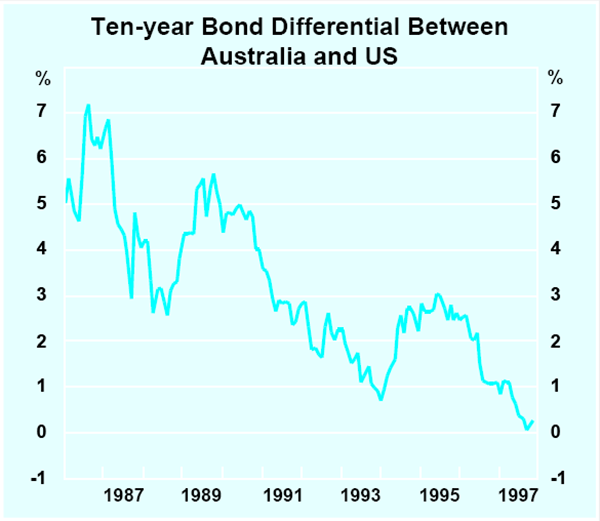
The sharp narrowing of the spread, to the point where it has almost closed, has occurred because Australia's better inflation performance relative to the US in the 1990s (2.7 per cent a year versus 3.4 per cent) is working to offset other factors which would normally result in a premium for Australian yields over US yields. These include Australia's lower credit standing and the lesser liquidity of the Australian bond market.
Differences in the cyclical position of the Australian and US economies have also contributed to the narrowing of spreads over the past year or so. The US economy is further advanced in its economic cycle, and therefore likely to be closer to experiencing upward pressure on inflation and monetary tightening, factors which would be helping to lift bond yields there relative to those in Australia.
Much of the yield curve in Australia has moved to a position below that in the United States in recent months (Graph A3). In mid 1996, before the latest easing in inflation and wage pressures, the yield curve in Australia was well above that in the United States at all maturities.
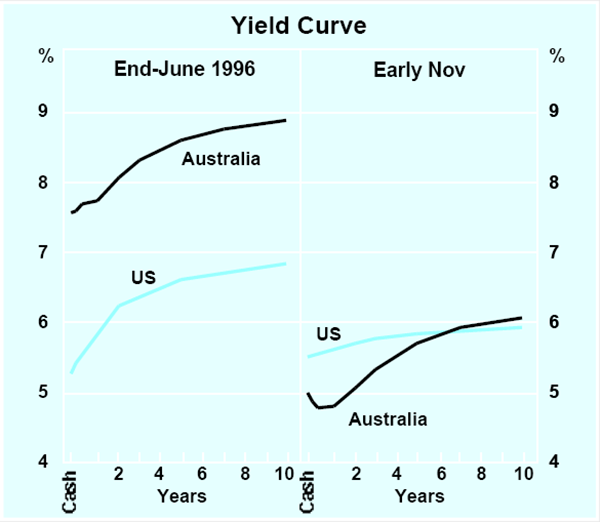
As well as domestic considerations, the narrowing of the bond spread reflects the international setting: most countries' spreads to the US have narrowed (Table A1). Australia's performance should be assessed against those of other previously high inflation countries, such as Italy and Spain, which have also done about as well. Apart from the United Kingdom, New Zealand and Sweden – on the high side – and Japan and Switzerland – on the low side – most industrial countries' bond yields are currently in a band around 5.5 and 6.0 per cent. The main factor in this convergence is that inflation is universally low, although progress in reducing budget deficits in most countries, including Australia, has also helped.
| Level of yields | Spreads to United States | |||
|---|---|---|---|---|
| 1980s(a) | Current | 1980s(a) | Current | |
| United States | 10.6 | 5.8 | .. | .. |
| United Kingdom | 11.3 | 6.5 | 0.7 | 0.7 |
| Canada | 11.7 | 5.5 | 1.1 | −0.3 |
| Australia | 13.5 | 6.0 | 2.9 | 0.2 |
| New Zealand | 14.0 | 6.7 | 3.4 | 0.9 |
| Germany | 7.6 | 5.6 | −3.0 | −0.2 |
| France | 11.7 | 5.6 | 1.1 | −0.2 |
| Italy | 14.5 | 6.3 | 3.9 | 0.5 |
| Sweden | 12.1 | 6.4 | 1.5 | 0.6 |
| Netherlands | 8.2 | 5.6 | −2.4 | −0.2 |
| Belgium | 10.6 | 5.7 | – | −0.1 |
| Switzerland | 4.6 | 3.6 | −6.0 | −2.2 |
| Spain | 14.4 | 6.0 | 3.8 | 0.2 |
| Japan | 6.7 | 1.6 | −3.9 | −4.2 |
| (a) Decade average | ||||
Acknowledging the progress of other countries does not diminish the benefits that have flowed to the local bond market as a result of the return to low inflation in Australia. While bond spreads will no doubt continue to fluctuate, Australia's record on inflation in the 1990s, good prospects that this performance will be sustained and the program of Budget consolidation have put Australia in a much better position to withstand market pressures on bond yields that may arise from time to time.
Assessments of the effects of recent events on the Australian economy are subject to considerable uncertainty. Much will depend on the size and duration of the slowing in growth in Australia's Asian trading partners, and what happens in the rest of the world – where the other half of Australia's exports are sold. While ever the acute difficulties were likely to be confined largely to the four ASEAN countries initially hit by the turbulence, the implications for Australia were likely to be reasonably contained. These countries take about 10 per cent of Australian exports, and supply about 6 per cent of Australian imports (Table 4). They account for 10 per cent of short-term visitor arrivals, and a quarter of foreign students studying in Australia. Merchandise exports to these countries have grown at a high average rate over recent years, slowing in 1996 but beginning to recover in 1997; a significant further slowing would have a noticeable effect on aggregate exports. Nonetheless, the bulk of the growth in exports to east Asia has been to the north-east Asian countries, which are much bigger markets – accounting for over 20 per cent of Australian exports. Since 1990, the total quantity of Australia's exports has grown at an average annual rate of 7½ per cent; about 1½ percentage points of this has come from the ASEAN-4 countries, and about twice that contribution has come from the other east Asian countries (Graph 6).
| Goods and services trade shares |
Investment shares | Inbound travel for education |
|||
|---|---|---|---|---|---|
| Exports to: |
Imports from: |
Australian investment abroad |
Foreign investment in Australia |
||
| Japan | 21 | 12 | 8 | 13 | 10 |
| China and NIEs(a) | 25 | 15 | 8 | 6 | 34 |
| European Union | 12 | 26 | 25 | 29 | 8 |
| United States | 7 | 21 | 27 | 23 | 7 |
| ASEAN-4 | 10 | 6 | 3 | 0.4 | 27 |
|
(a) Hong Kong, Singapore, South Korea and Taiwan Sources: Balance of Payments and International Investment Position 1995–96 (ABS Cat. No. 5363.0) and ABS special data service |
|||||
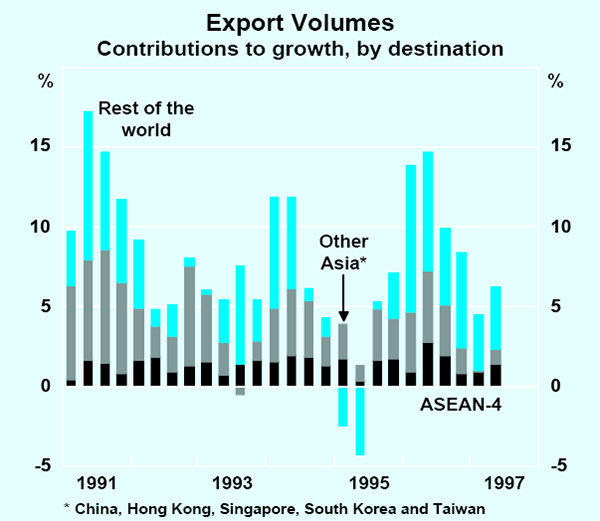
The slowing in ASEAN itself would not necessarily lead to a major reduction in growth in north-east Asia: the trade exposures of those countries to ASEAN are generally no higher than Australia's (Table 5). Most of the north-east Asian countries have experienced an acceleration in their own export growth over recent months, after a pronounced slowing in 1996 (Graph 7). This has tended to hold out some hope that Australian exports would in turn grow more quickly, and on the most recent data, this appears to have been happening (Graph 8). The danger now is that financial fragility, and/or tight financial policies in the wake of the market volatility of recent months, may retard growth in a broader group of countries. This risk appears to be largest in South Korea, where despite a pick-up in export growth over recent months, and continued robust growth in industrial output, corporate insolvencies have sapped confidence and strained the banking system.
| ASEAN-4 | Japan | Other Asia | US | Europe | Others | |
|---|---|---|---|---|---|---|
| South Korea | 9 | 12 | 28 | 17 | 15 | 19 |
| Japan | 12 | – | 32 | 28 | 17 | 11 |
| China | 3 | 20 | 34 | 18 | 16 | 8 |
| Hong Kong | 4 | 7 | 44 | 21 | 17 | 8 |
| Taiwan | 8 | 12 | 32 | 23 | 15 | 10 |
| Singapore | 28 | 8 | 23 | 18 | 15 | 7 |
| Thailand | 6 | 16 | 30 | 18 | 18 | 11 |
| Malaysia | 7 | 14 | 37 | 19 | 15 | 7 |
| Indonesia | 6 | 29 | 21 | 17 | 19 | 9 |
| Philippines | 8 | 18 | 17 | 34 | 18 | 5 |
|
Sources: IMF International Financial Statistics, IMF Direction of Trade, national governments |
||||||
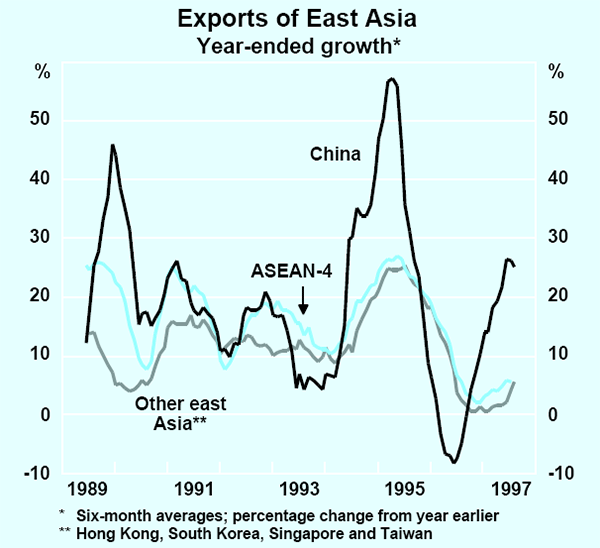
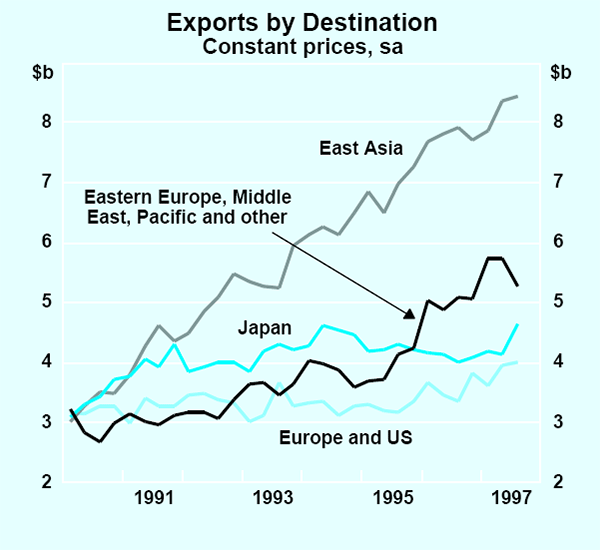
While these events play out, the Japanese recovery appears to have suffered another setback. The June quarter accounts showed a much bigger than expected fall in GDP of 2.9 per cent, and business sentiment, as recorded in the Tankan survey, has deteriorated in recent months (Graph 9). The existing difficulties of the Japanese banks may be exacerbated by the recent financial market turbulence throughout Asia. The Japanese economy has experienced weak economic performance for some years now, and Australian exports to Japan have recorded virtually no growth over the past five years. This hindered overall export performance much less than might have been expected, because the considerable expansion in other Asian countries allowed exporters to find alternative growth opportunities. Looking forward, the likelihood that south and north-east Asian trading partners will experience slower growth for a time, while Japan remains weak, provides a difficult external environment for Australia.
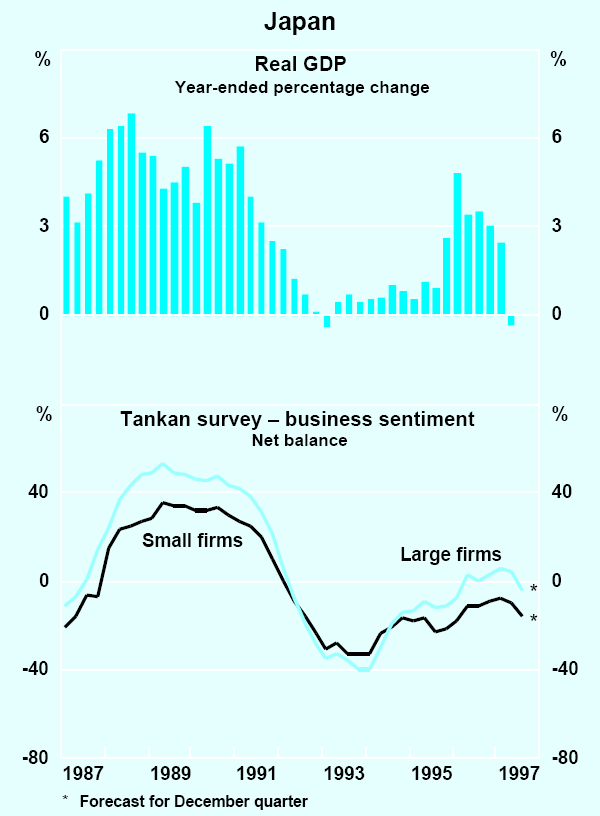
Another effect on Australia could be through the property market as Asian investors have been active in purchasing units in high-density residential developments over the past few years. This activity might be expected to slow.
The Australian economy is well placed, however, to weather the worst of the financial shock which has hit the region. An important factor which determines the extent to which declines in asset values have a broader impact on the economy is the extent of leverage. Holdings of equities in Australia are not routinely financed with borrowed funds; property prices have not staged a large run-up, except in inner city residential areas, which makes the probability of a major, broadly based decline reasonably low; lenders are well capitalised and the credit process is working well. So while there will almost certainly be some, as yet unquantifiable, dampening effect on the Australian economy operating through trade channels, this should not be compounded by financial difficulties.
United States and Europe
Also important in an overall assessment of Australia's external environment are developments in the United States and Europe. In contrast to the situation in east Asia, the United States economy continues to record good growth, while growth in the major European economies appears to be picking up after a prolonged period of weaker performance. These trends will help to provide a base of support for external demand and may, to some extent, mitigate some of the effects on Australia of the east Asian difficulties.
The United States economic expansion has been a remarkably steady one, with year-ended growth rarely outside the 2 to 4 per cent range since 1992; over the past year, growth was 4 per cent (Graph 10). The unemployment rate has been on a trend decline throughout the expansion, reaching 4.9 per cent in September 1997. Despite the tightening labour market, inflation has so far remained subdued, with core consumer prices rising by only 2.2 per cent in the year to September, their lowest annual rate of increase since 1966.
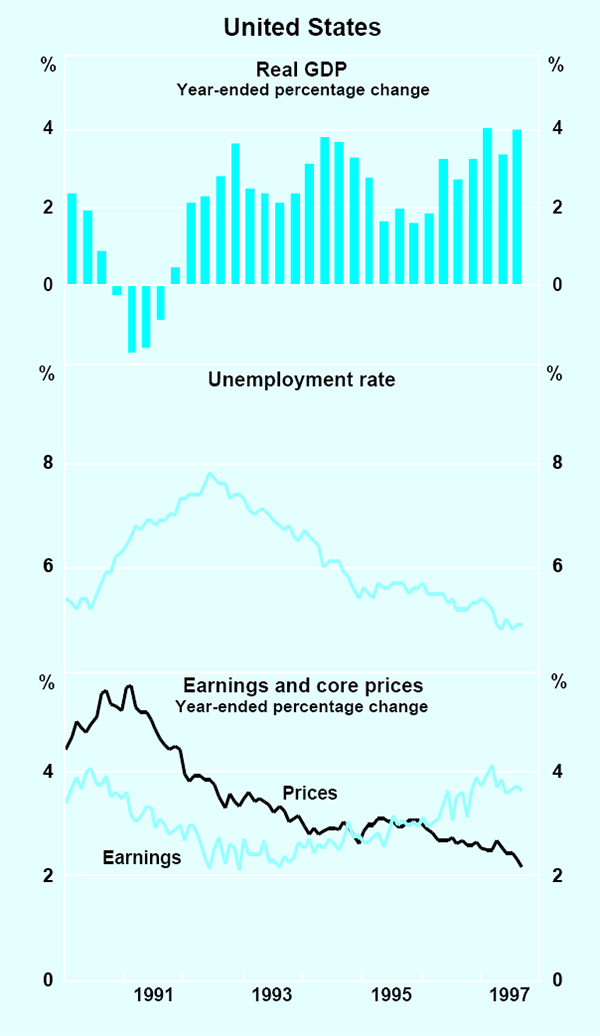
Activity in the three largest continental European economies (Germany, France and Italy), after having been sluggish for several years, now appears to be picking up a little faster than had been expected. The European Commission has recently revised upwards its forecasts for growth across the European Union by 0.2 percentage points in both 1997 and 1998, to 2.6 per cent and 3.0 per cent respectively. Signs of strengthening in the large continental economies are particularly apparent in their industrial production data. Consumer price inflation remains relatively subdued, although a pick-up in import prices in Germany has pushed up inflation rates there a little. This prompted a rise in short-term rates in Germany in October, which was followed by France and several smaller countries. In the United Kingdom, output rose by 3.9 per cent in the year to the September quarter, underpinned by strong domestic demand and an unemployment rate that continues to fall. The Bank of England has gradually raised the interbank rate to its current level of 7 per cent to resist inflationary pressures flowing from the tight labour market and strong demand.
Domestic Economic Activity
The Australian economy has grown a little faster during 1997 than in 1996. In the first half of 1997, real GDP expanded at an annualised pace of just under 4 per cent, following a relatively weak second half of 1996, when growth was about 2 per cent (Table 6). In the non-farm sector of the economy, the turnaround was a little more marked, from around 1½ per cent in the latter half of 1996 to 3¾ per cent in the first half of 1997.
| Six months to: | Year to | ||
|---|---|---|---|
| December 1996 | June 1997 | June 1997 | |
| Private demand(a) | 2.6 | 4.8 | 3.7 |
| of which: | |||
| Consumption | 1.6 | 2.8 | 2.2 |
| – Goods | −0.2 | 2.9 | 1.4 |
| – Other(b) | 4.1 | 2.3 | 3.2 |
| Dwelling investment | 1.6 | 15.8 | 8.5 |
| Business investment(a) | 9.9 | 8.3 | 9.1 |
| Public demand(a) | 2.7 | 5.1 | 3.9 |
| Private non-farm stocks(c) | −0.7 | 0.5 | −0.1 |
| Net exports(c)(d) | −1.0 | −0.4 | −0.7 |
| GDP(E) | 0.7 | 4.1 | 2.4 |
| GDP(A) | 2.5 | 3.9 | 3.2 |
| (a) Excluding asset transfers (b) Excluding dwelling rent (c) Contribution to growth in GDP(E) (d) Excluding RBA sale of gold |
|||
Growth has been supported by a solid expansion of private-sector final demand, which over the past couple of years has been increasing at a rate of about 4 per cent. Strong growth in business investment has continued to be a major driver of the expansion to date, with dwelling investment now beginning to play a more prominent role. Private consumption appears to have strengthened recently, after a weak showing in 1996. For a time, some of this growth of domestic demand was supplied by running down inventories, so that output ran behind. In addition, a slowing in export growth in 1996 and early 1997, particularly to a number of countries in north-east Asia, meant that net absorption of Australian output by the rest of the world declined. More recently, however, the inventory correction appears to have largely run its course, while a stronger performance of the north-east Asian economies during 1997 to date has seen a pick-up in export growth since March.
The latest available data suggest that the expansion is continuing, with signs that employment growth may be starting to respond to the firmer trend in production. If so, the resulting growth in household incomes will support ongoing growth in consumption. Question marks remain over the outlook for exports, arising from a likely slowing in east Asian economies next year and the possibility of wider repercussions. The following sections cover the household and business sectors and Australia's balance of payments.
Household income and expenditure
Consumer spending on goods has been rising during 1997, after a period of weakening demand through the second half of 1996. The strength of the upward trend has been difficult to gauge, because of the effects generated by shifting timing of holiday-related spending. Retail sales around Christmas 1996 were unusually weak. Demand then strengthened appreciably early in 1997, only to slow again from March to May. More recently, stronger growth has resumed, with retail trade in the September quarter rising by 3.1 per cent in real terms, after a decline of 0.3 per cent in the June quarter (Graph 11). Over the year to September, growth was 3.8 per cent, compared with a fall of 0.6 per cent over the year to December 1996.
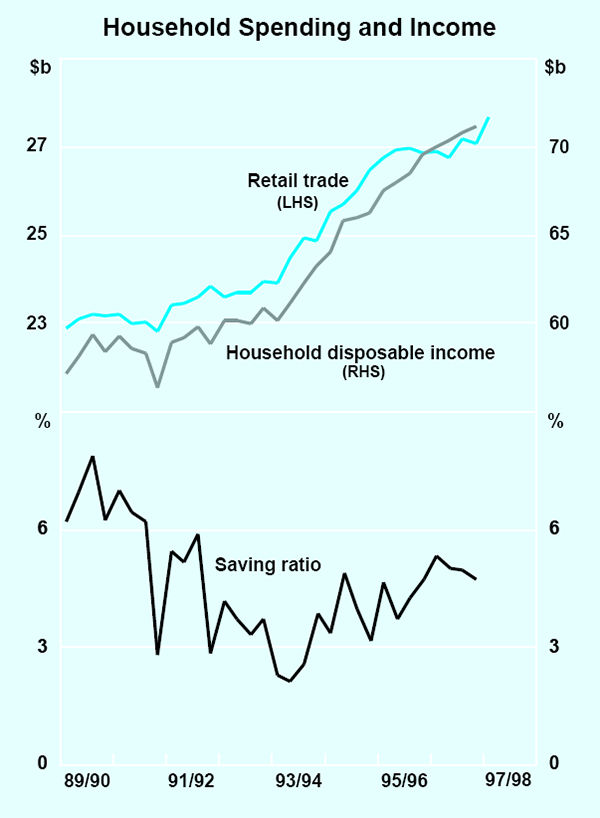
The detailed data for retail trade show differing patterns of growth between types of expenditure, with growth in demand for services over the past year generally stronger, by a good margin, than for goods. This pattern is even clearer in the national accounts estimates for private consumption, where the items recorded in the monthly retail trade data make up a little under half of consumption outlays for households. Estimates for spending on the other half – the broad range of services which includes recreation, entertainment, telecommunications and financial services – suggest quite robust growth. This reflects the continuation of the structural change towards services which has been occurring in the economy for many years.
Demand for motor vehicles has increased substantially over the past six months. Registrations of passenger vehicles in the September quarter were 15 per cent higher than a year earlier. Some of this expansion in demand has been prompted by highly competitive prices for imported vehicles, which have taken a large share of the increased expenditure. Nonetheless, demand for vehicles across the board has been increasing. This has been assisted by declining interest rates, as attested by a noticeable strengthening in personal finance commitments for motor vehicles.
Growth in household income has been lower than usual over the past year, as a result of sluggish employment. This trend may have been one factor in constraining spending by households, although the timing of the slowing suggests that the deceleration in income was as much a result of the slowing in consumer demand as a cause of it. Households appear to have lifted their saving rate a little over the past year or so, after a period of several years in which saving rates fell. They may have tended towards a rather cautious attitude to expenditure, particularly under conditions of labour market uncertainty. Over much of the past year, information available from surveys of consumer sentiment has suggested heightened pessimism about employment prospects, although this appears to have abated in the most recent surveys. Overall consumer sentiment indexes have remained at levels above their historical averages throughout the past couple of years. People remain considerably more optimistic about their own personal financial situation than about the economy generally.
Demand for residential property has increased significantly over the past year. Over the three months to August 1997, new loans totalling $17 billion were approved by housing lenders, some 38 per cent more than in the corresponding period a year earlier. As is usually the case early in a housing upswing, a large part of the finance has been for the purchase of existing dwellings by owner occupiers, but finance approvals for construction or purchase of newly erected dwellings have also increased strongly over the past nine months. In value terms, these are now about 40 per cent higher than a year ago (Graph 12).

This increase in borrowing has been facilitated by the substantial reduction in mortgage interest rates which has occurred over the past year. With the reduction in cash rates and the increased competition amongst lenders in the market, interest rates for borrowers have fallen to their lowest levels in a generation. More generally, in the 1990s as a whole, the advent of low inflation, and the much lower structure of interest rates which has occurred as a result, have eased the debt servicing burden of many households. In some cases, this is allowing households to pay off debt faster than might otherwise have occurred – that is, to increase their saving; in these instances, the potential to expand consumption in the future would be enhanced. In most cases, however, households have made greater use of borrowing, and household debt levels have increased substantially in the 1990s (Box B), as lower interest rates have made it feasible to service larger loans.
Box B: Inflation, Interest Rates and Household Debt
The structural decline in inflation in Australia during the 1990s has allowed a major decline in interest rates. The fall in interest rates for home borrowers has been particularly marked, due to the additional effect of increased competition in the housing loan market. As a result, housing loan rates are now well below their low points reached in the early 1990s, when the economy was much weaker than at present, and are at levels last seen in the late 1960s and early 1970s.
Quite important implications have flowed from this structural change. The first is that the ‘affordability’ of housing has increased considerably. Servicing costs on a standard variable-rate loan relative to average household disposable income have fallen sharply, and are currently lower than at any time since housing loan rates were deregulated in the mid 1980s (Graph B1, upper panel). It would be possible to find periods prior to deregulation when the servicing costs for the standard loan were lower than at present, but that is not a relevant comparison since loans were much less widely available (at least from banks) and borrowers often needed to take out more than one loan in order to fund a house purchase. Hence, it is safe to conclude that the accessibility of housing finance has increased markedly over the 1990s. It is likely that this change, other things equal, will prove to be of considerable advantage to low-income earners.
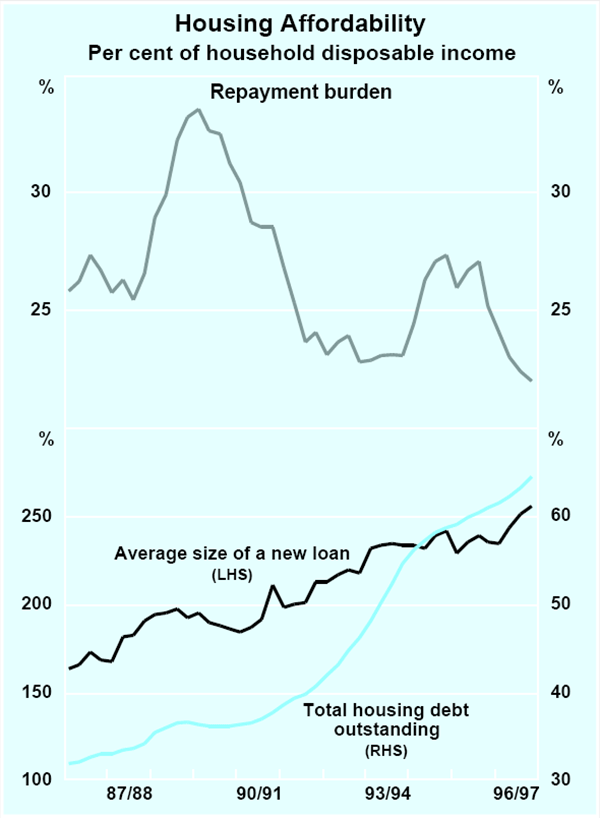
Households are tending, in many instances, to use the decline in interest costs to service much larger loans. The average size of new loans approved to owner occupiers has increased by 60 per cent since 1990, and is now about 2½ times average annual household income (Graph B1, lower panel). It is also likely that more households have loans, though there are no timely data which measure that directly (and in fact, as of 1995/96, the majority of households were not paying off a housing loan, either owning their home outright or renting). The repayment burden would have fallen much further in the absence of this increase in loan size.[1] It is also likely that in some areas, the lower interest rates and larger loans are serving to accommodate upward pressure on house prices, though that is not widespread at this stage (see main text).
These trends have lifted the levels of gross debt carried by the household sector considerably. For the purposes of making international comparisons, it is necessary to add other personal loans and loans to unincorporated businesses. Data compiled on this basis are shown in Graph B2. Until recently, Australian households and unincorporated businesses carried relatively little debt compared with those in other developed countries. As of 1996, Australia was closer to the median for this group of countries. As such, the present level of debt is not a major concern, though its current rate of increase (of around 10 per cent) is unlikely to be sustainable indefinitely in an economy where growth of nominal incomes is of the order of 5–6 per cent.
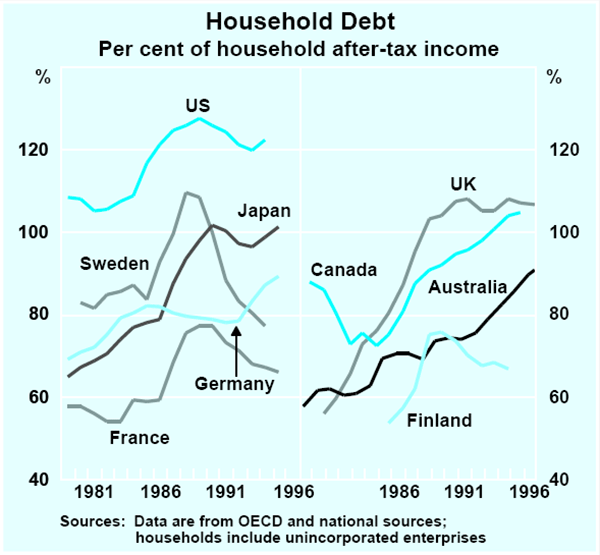
This increased recourse to borrowing resulting from lower interest rates is being reflected in the residential property sector both in the form of higher prices for existing dwellings, and increased construction of new dwellings. Price rises have been most noticeable to date in Sydney, particularly in the inner suburbs, and in Melbourne. An overall measure of Sydney prices published by the REIA shows an increase of about 10 per cent over the year to June 1997; for suburbs reasonably close to the CBD, the increase has been of the order of 25 per cent. Areas further out have shown much smaller increases. There also appears to be an upward trend in areas of Melbourne, where prices overall have risen significantly over the past year. An upturn in prices appears to have commenced in some other cities as well.
Approvals to build private dwellings began to increase around the turn of the year, and rose quite quickly through to May. They then fell away for a couple of months, but remain on a gradual upward trend. In September, approvals were 20 per cent higher than a year earlier. Dwelling commencements began to increase in the March quarter and, despite a fall being recorded in June, should show a rise in the September quarter and beyond.
There is little doubt that the housing upswing will continue. Several features of the current cycle, however, are unusual. The first is the prominent role of investors, which account for about one-third of the total value of lending approved for housing, about the same as in the peak of the late 1980s, but up from one-sixth in the early 1990s. Associated with this, the indicators of construction show a higher proportion of approvals are for multi-unit dwellings than on most previous occasions. This may reflect a structural change in the way Australians are choosing to house themselves, with a trend towards higher density living, including in the inner areas of the larger cities. There has probably been some effect of the interest of Asian investors, which is now likely to abate.
A second feature is a substantial increase in the average real value of a building approval. This is not price inflation – indexes of prices of building materials have shown only small increases in recent years, although they are now increasing a little more quickly. It appears to reflect an increase in the size and quality of new dwellings. In essence, new dwellings on average have more rooms and better quality fittings than used to be the case; in real terms, the average value per dwelling of new building approvals is now about 20 per cent higher than it was at the beginning of the decade.
The third noteworthy feature of the present upswing is its geographical unevenness. The strength in construction activity continues, on the most recent data, to be concentrated in Victoria and New South Wales. Other areas, particularly Queensland, which has in the past accounted for about a third of the annual increase in the dwelling stock, have not seen a strong pick-up in activity as yet. This is likely to be, in part, a reflection of lingering excess supply of dwellings left over from the previous upswing. That upswing, which finished in 1994, was unusually long, and over a three-year period saw more dwellings constructed than at any time since the early 1970s. The excess supply will, in due course, be cleared, leading to increased construction activity in these other areas. A possible implication of these currently diverse trends is that the housing cycle could be sequential in nature, with less of the characteristics of a nationwide ‘boom’, than seen in the past.
The business sector
Companies have found it harder to sustain growth in profits over the past couple of years, in the face of more moderate output growth, rising labour costs in some areas and the discipline on prices arising from subdued demand conditions and increased competition in domestic and international markets. For those involved in exporting, a slowing in export sales during 1996 also will have made for more difficult trading conditions. In 1996/97, operating profitability of the private corporate sector, as measured in the national income accounts (adjusted for privatisations),rose by about 1 per cent, after an increase of 6½ per cent in 1995/96. These figures compare with an average increase of nearly 9 per cent in the preceding two years. As a share of GDP, corporate profits remain near their average level of the past decade or so, but have tended to decline a little over recent quarters. Net profits reported by major listed companies have in a number of instances been reduced by the effects of writing down the value of assets, often those acquired in international expansion programs earlier in the 1990s.
Companies have been responding to these pressures on profitability in a variety of ways. One element of adjustment over the past year has been to control inventories tightly. Stronger demand early in 1997 for goods was substantially met from stocks. On the most recent data, the process of running down stocks appears to have been largely completed. Most industries have stocks to sales ratios in line with historical trends.
Another response to profitability pressures has been labour shedding. Many large-scale and medium-size enterprises continue to rationalise their workforces, looking to eliminate past practices which led to overstaffing, to contract out many non-core activities to specialist firms which can provide them more cheaply, and so on. Public enterprises approaching or undergoing privatisation have also tended to shed staff. In some areas where labour's bargaining power is relatively strong, such as parts of manufacturing and finance, substantial pay rises have occurred simultaneously with sizeable workforce reductions.
These forces are, of course, always at work but are more visible in periods where overall economic growth is weaker. The longer-run pay-off from rationalisation of corporate operations is that productivity growth improves, the economy's potential growth rate increases, and investment and employment increase. Aggregate data on productivity increasingly confirm what anecdotal evidence has been suggesting for some time: that the trend productivity growth of the factors of production in Australia, as summarised by total-factor productivity, has lifted noticeably during the 1990s (Box C). Productivity growth in Australia appears to be outpacing the average for developed countries in the 1990s, after many years of lagging behind. There is, nonetheless, much ground to make up. Some questions also remain about the relationship between wages and labour productivity, and these are taken up in the section on labour markets below.
In the period ahead, firming growth offers the prospect that profitability will be sustained, and improved. Inventory levels are well controlled. Broader indicators of business sentiment continue to suggest confidence about the medium-term future, recent difficulties notwithstanding. If anything, in recent surveys this confidence about expected trading conditions has increased further (Graph 13). Indicators of current trading conditions have not changed much, although it is worth noting that while this fact sometimes is reported as though conditions are weak, many of the relevant data series are at or above their longer-run average. These business confidence indicators suggest that an expansion in employment is more likely, provided growth in labour costs is contained, and some firming of employment growth prospects is confirmed by the bulk of business surveys, and by higher levels of job vacancies. The recent employment data suggest that this growth may have begun, although it is too early to be sure of this yet.
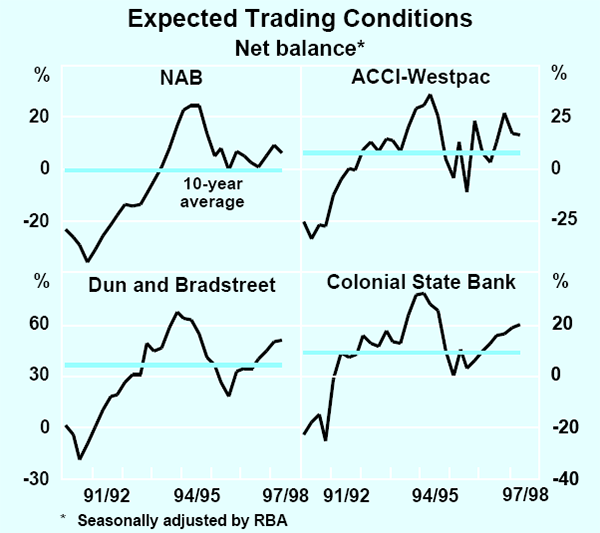
A reflection of reasonable levels of confidence has been the fact that throughout the recent period of slower output growth, business investment activity has remained quite strong. In the June quarter of 1997, investment spending was 9 per cent higher, in real terms, than a year earlier. This was a slower rate of increase than had been recorded in the preceding 12 months, but was much faster than the rate of growth of most other components of spending in the economy.
Strength continued to be concentrated in equipment investment, which increased by 13 per cent over the year to June. This came after a five-year period in which the average rate of increase for equipment investment was over 10 per cent in real terms. As a share of GDP, investment spending on equipment has returned from quite low levels reached during the recession in the early 1990s to about its longer-run average (Graph 14). Forward looking indicators for equipment investment have for some time been signalling that its rate of increase could slow during 1997/98. Initial estimates for 1997/98 in the ABS Capital Expenditure Survey, in fact, suggested a decline in this component of investment spending. The most recent estimates suggest a significant upward revision of intentions, such that a slightly higher level of investment is now on the cards in the current year. Nonetheless, this would represent a noticeable slowing in its rate of growth.

Box C: Productivity Growth – An Update
The first Semi-Annual Statement on Monetary Policy, published in May this year, compared growth in labour and total-factor productivity in the current economic expansion with their growth in the corresponding phase of the two previous business cycles. The data presented showed growth in labour productivity in the current expansion to be substantially stronger than in the 1980s expansion, but weaker than in the 1970s. By contrast, growth in total-factor productivity – which is a more comprehensive measure of the efficiency with which all inputs in the economy are combined to produce output – was shown to be stronger in the current expansion than in either of the previous two expansions.[1] This was taken as evidence that the extensive structural changes in the economy over the past decade appeared to have led to an improvement in Australia's underlying rate of productivity growth.
This box updates the results presented six months ago. The addition of two more quarters of data, as well as revisions to the latest national accounts, now imply a larger increase in total-factor productivity growth than previously reported.[2]
There is some cyclical variation in measures of both labour and total-factor productivity; when comparing productivity performances between economic cycles, it is therefore appropriate to measure productivity over common phases of the cycle. With the current expansion having now run for six years since the trough in output in June 1991, a comparison of recent productivity growth with that in the previous two business cycles can be conducted on a comparable basis by measuring productivity over the six years from successive troughs in output. On this basis, trend labour productivity growth in the current expansion is still estimated to have been weaker than in the 1970s expansion, but significantly stronger than in the 1980s expansion (Table C1).
| Period(a) | Annual percentage growth in: | |||
|---|---|---|---|---|
| Trend labour productivity(b) | Capital stock | Labour hours worked | Trend total-factor productivity(b)(c) | |
| Mar 1975–Mar 1981 | 2.1 | 3.6 | 1.1 | 1.2 |
| Mar 1983–Mar 1989 | 0.7 | 3.2 | 3.4 | 0.8 |
| June 1991–June 1997 | 1.6 | 2.3 | 1.5 | 1.6 |
| (a) Each period extends for six years from a trough in non-farm output. (b) Calculated by fitting a trend through the quarterly estimates of the level of labour (or total-factor) productivity. (c) Estimated from labour productivity growth assuming a standard production function with capital and labour inputs. Note: The method of calculation used in Table C1 differs from that in the corresponding table in the first Semi-Annual Statement on Monetary Policy. For both labour and total-factor productivity, the table now shows trend rates of growth, rather than the rate of growth implied by joining the first and last data points. Using the previous method over the six-year periods in the table gives labour productivity growth estimates in consecutive expansions of 2.2, 1.0 and 2.1 per cent, and total-factor productivity growth estimates of 1.2, 1.1 and 1.8 per cent. This method therefore confirms that total-factor productivity growth has been much stronger in the current expansion than in the previous two. |
||||
The changing capital intensity of the economy explains some of the differences in labour productivity between business cycle expansions. Labour productivity growth was boosted in the 1970s as businesses tended to substitute capital for labour following the large increase in real wages. In the 1980s expansion, hours worked grew more rapidly than the capital stock in a climate of real wage restraint. When adjustments are made for these changes in capital and labour inputs by calculating total-factor productivity, a slightly different picture emerges. Total-factor productivity grew at trend rates of 1.2 and 0.8 per cent in the first two expansions; in the 1990s expansion, it is estimated to have grown significantly faster at a trend rate of 1.6 per cent (Graph C1).
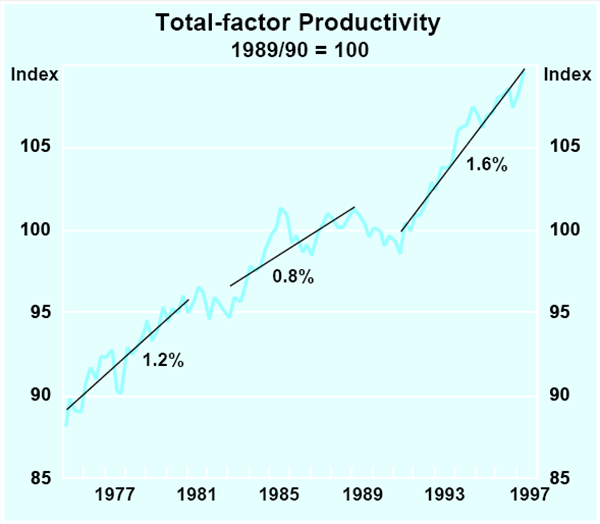
In some respects, such a pause in the investment cycle would not be altogether surprising, given that a number of years of strong growth have occurred, and the fact that in areas such as manufacturing, rates of capacity utilisation have tended to decline over the past two years. Firms would have the option of waiting for higher output growth to take up some of the existing capacity, before feeling the need to add to it. Investment spending over the past year or two has also been boosted to some extent by the telecommunications sector, with cable roll-outs etc. Investment at that pace could not continue, although there can be little doubt that reasonably high rates of investment in communications and computer technology are likely to be a feature of the economic scene for the foreseeable future.
In contrast to equipment spending, spending on buildings and structures is recorded to have weakened in the middle of 1997. This particular observation appears to reflect the completion of the Crown Casino in Melbourne, work on which had pushed up investment data for several previous quarters. The most recent ABS survey suggests that this type of spending is likely to decline in 1997/98, although this component of the survey is likely to be less reliable than that relating to equipment investment. Together, these indicators could be taken as suggesting that the construction cycle has already peaked and turned down.
If such an outcome were to eventuate, it would be surprising in several respects. Construction has been much slower to resume growth than was spending on equipment after the early 1990s recession, due in large measure to the over-investment of the late 1980s. It would seem unlikely for that upswing to have already finished. The number of non-residential building approvals exhibited weakness during the first half of 1997, but has increased strongly again in recent months with rises recorded in most categories. Taking into account engineering construction, which is much more prominent in this cycle than in the late 1980s, the pipeline of work to be done is quite substantial (Graph 15), with several infrastructure projects and large amounts of long-term investment in the mining sector under way. Hence it seems unlikely that a substantial decline in construction activity will occur over the next year; a modest further expansion is more likely. This judgment is consistent with persistent reports of skill shortages and pressure on wages in the construction sector.
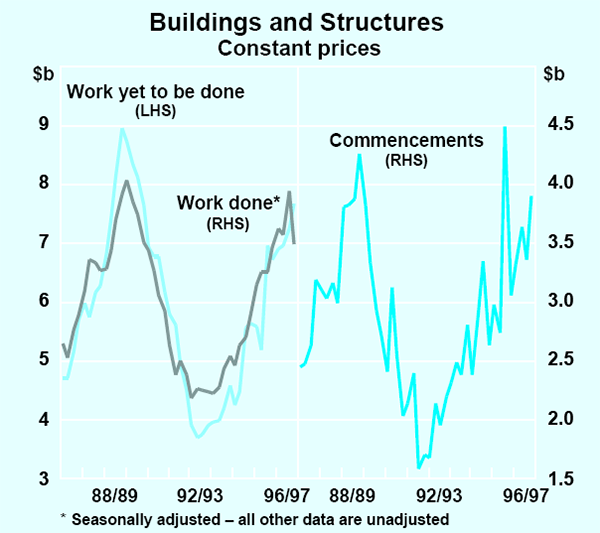
While rates of investment growth seen in recent years may not be sustainable, there is little reason to expect a substantial decline in investment while the corporate sector and the economy generally remain free of major imbalances. Firms' financial situations are certainly no constraint on their activities. In regular business surveys, few firms nominate the cost or availability of credit as a significant impediment to their operations. Business demand for credit from financial intermediaries appears to have strengthened a little over recent months. Business credit outstanding rose at an annualised pace of over 13 per cent in the six months to September, compared with 7 per cent in the preceding six months. Data on commercial finance commitments also show an increase over the past six months or so (Graph 16). Equity raisings have also been strong this year, helped by a rising share market. Over the six months to August, raisings of new equity, apart from privatisations, totalled $6.6 billion, the highest rate for two years. Despite these increases, firms now appear to be in a phase where leverage is starting to increase a little, after a number of years when it was stable or falling. Competition amongst lenders has resulted in a slight decline in credit standards over the past year or so. The impact of recent financial turbulence on these trends is not yet clear, although the volatility of the stock market may make equity raising more difficult for a time. Uncertainty surrounding the international environment could also prompt a more cautious attitude to business investment in some areas.
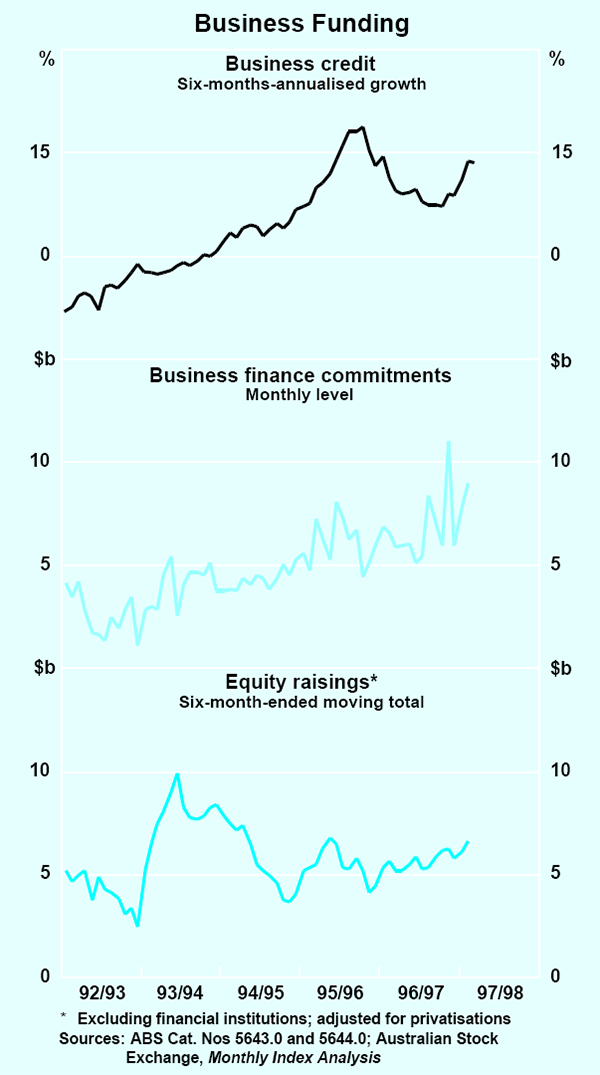
The rural sector
Signs developed during 1997 of a strong El Niño event, which involves a sustained warming of the central and eastern tropical Pacific Ocean, usually leading to drier-than-normal weather conditions over eastern Australia and south-east Asia. Consistent with the signs of El Niño, rainfall over much of eastern Australia was below average in the three months to the end of August (Graph 17). Against the odds, however, many parts of Australia received well-above-average rainfall in September and October.
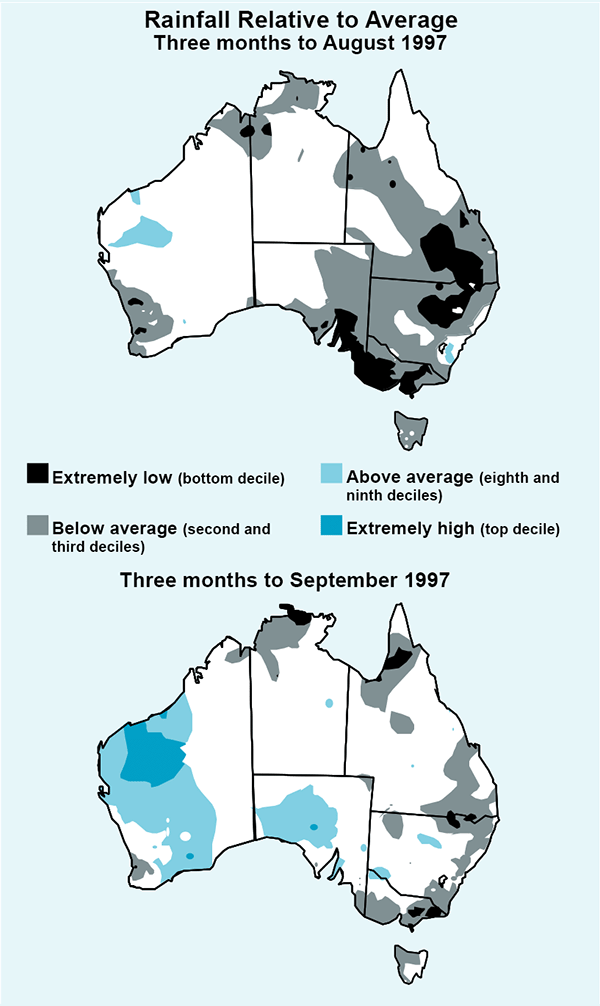
With the signs of El Niño still present, meteorologists continue to forecast below-average rainfall for eastern Australia into early 1998. But with the recent rains having occurred at a critical time for the winter grain crop, the Australian Wheat Board has revised up the 1997–98 wheat production forecast substantially.
Meat production, which accounts for about one-quarter of farm output, rose by 5 per cent in 1996–97 as farmers increased slaughterings in response to their expectations of drought. Beef exports to north-east Asia have strengthened, with the value of exports to Japan – Australia's largest market – in the first nine months of 1997 up by 9 per cent over the same period last year. Live cattle exports continued to grow strongly in 1996–97, but have softened since then. Conditions improved in the wool industry, with stronger demand from China, Italy and Taiwan, which together accounted for about half of wool exports in 1996–97.
Balance of payments
Import volumes have picked up as economic activity has strengthened in 1997. Following a relatively weak March quarter, the quantity of imports rose strongly in the June quarter, and into the second half of 1997, particularly imports of consumption and intermediate goods (Graph 18). The rise in consumption imports has been fairly broadly based, but with motor vehicle imports being particularly strong. Capital imports rose by 15 per cent over the year to June 1997 reflecting the strong investment in plant and equipment over this time; since then capital imports have flattened out at a relatively high level. Service imports have also been reasonably firm, growing by 7.5 per cent in 1996/97, with strength concentrated in shipment and other transport services.
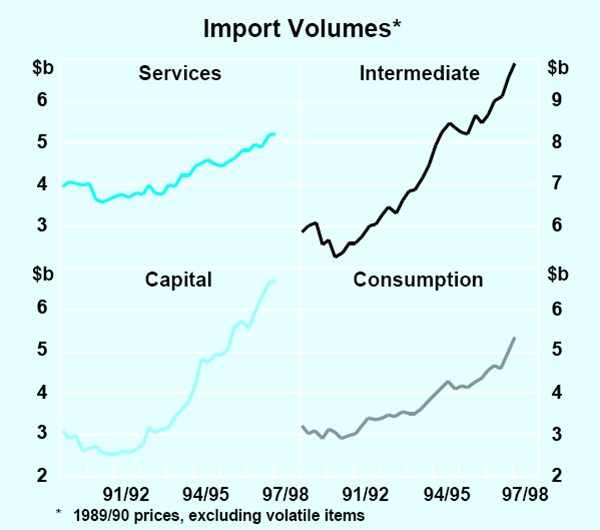
Export volumes have also firmed. Excluding one-off factors (the sale of gold and a frigate), exports of manufactured and resource goods appear to have been notably stronger in 1997 than in the latter half of 1996. This seems to reflect improved demand from our major trading partners in north-east Asia in the first half of this year, following a period of weakness in 1996. Rural exports rose by 13.5 per cent in 1996/97 following a bumper wheat harvest. As yields return to more normal levels, rural exports are expected to fall somewhat although, so far, they have shown surprising resilience. As discussed above, recent developments in east Asia raise some important risks to the outlook for exports to the region.
Net payments on Australia's external liabilities – the net income deficit – rose from $4.6 billion in the March quarter to $5.1 billion in the June quarter. This rise was due primarily to stronger income debits, reflecting higher dividend payments on foreign investment in Australia; income credits also rose marginally. The current account deficit also rose somewhat, from a little over 3 per cent of GDP in the March quarter to around 3¾ per cent in the June quarter (after excluding the gold and frigate sales). This rise reflected both the rise in the net income deficit and the strength in imports.
Commodity prices
Commodity prices in aggregate have shown little change over the course of 1997, having previously risen to a level about half way between their recent low in 1993 and their latest peak in 1990 (Graph 19). Reflecting continued falls in import prices, Australia's terms of trade have increased steadily since the trough in 1993.

Non-rural commodity prices have been quite stable over 1997, with strength in base metal prices, which have risen by more than 10 per cent since December 1996, having been offset by a weaker gold price; oil has traded in a narrow range around US$20 a barrel since early in 1997. Rural prices are about 10 per cent higher than they were at the start of the year, mainly due to stronger prices for wool and sugar. The wool price has risen by 25 per cent since the end of 1996 and is now more than 10 per cent above its average level over the past five years, reflecting stronger demand from Europe and China. In contrast, wheat prices have fallen since the middle of the year, reflecting a particularly large expected US wheat harvest and expanded production in Europe.
The labour market
Employment in the early and middle part of 1997 was weak, but seems to have improved recently (Graph 20). In the first half of the year there was a shift in the mix of employment towards part-time work, continuing the longer-run trend in that direction, so that the decline in full-time employment was greater than the total decline (Graph 21). Since June, however, this situation has been reversed, and full-time employment has been picking up. For much of the past year, labour force participation was declining, reflecting the weaker demand for labour in evidence until recently. The unemployment rate has continued to fluctuate around 8½ per cent, as it has for the past two years.
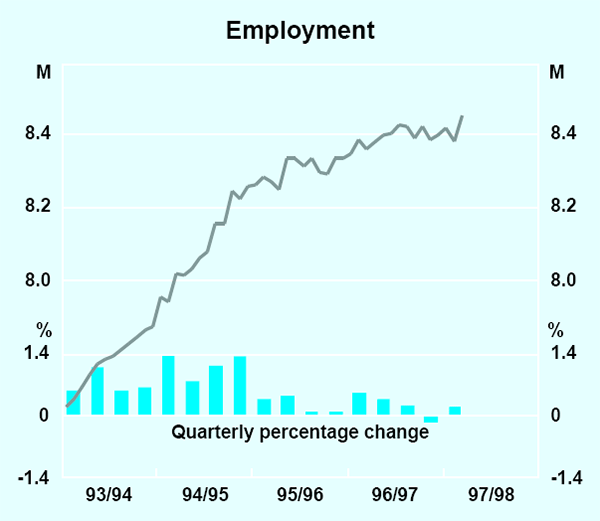
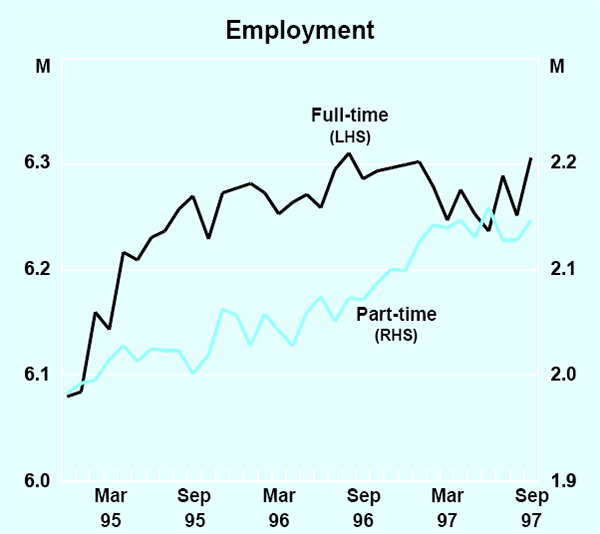
Volatility of the monthly employment figures makes the trends difficult to interpret, but the recent pick-up in full-time employment may signal some firming in the demand for labour. Alternative ‘matched sample’ estimates of total employment also point to some pick-up in recent months. These estimates are a little less volatile than the published data, and suggest modest increases in employment in both the June and September quarters (Box D).
With employment growth normally lagging behind developments in activity, the weaker employment trend evident in early and mid 1997 reflects, to an important degree, the subdued pace of growth in 1996. Growth in non-farm GDP in 1996 was 2.6 per cent and, in the second half of the year, slowed to an annual rate of 1.6 per cent, well below the average growth rate in the course of the current economic expansion to date, and below the economy's growth potential. Given this slowing in GDP growth, it is not surprising that the employment trend also weakened significantly. Conversely, although the time lags are uncertain, the pick-up in growth under way in 1997 can be expected to be followed by stronger employment growth in the latter part of the year.
The industry composition of employment changes over the year to August shows quite wide variations in labour market conditions (Graph 22). Relatively large employment reductions over the year are recorded in public administration, while employment also declined in other industries with traditionally high public-sector involvement, namely education, utilities and communication, as well as in mining and construction. In contrast, growth was relatively robust in the private-sector service industries such as property and business services, personal services and recreation.
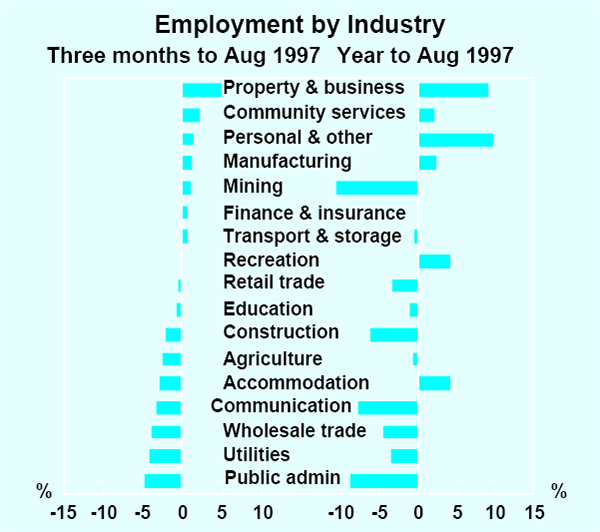
Consistent with the stronger growth in activity occurring in 1997, there are a number of signs from the forward-looking indicators that the demand for labour may be firming. The number of job vacancies has been showing a modest upward trend for some time, although both the ABS and ANZ vacancies series have been subject to some short-term volatility. Business surveys suggest that hiring intentions have improved recently. In contrast, overtime hours worked have remained flat at a level not far above last year's trough. In part, this may reflect continuing absorption of regular overtime into standard working hours under the terms of many enterprise agreements.
Box D: Employment Growth – ‘Matched Sample’ Estimates
The Australian Bureau of Statistics publishes an estimate of employment in Australia each month, based on the Labour Force Survey in which 30,000 people are interviewed. The survey consists of eight sub-samples of roughly equal size. Each month, one of the sub-samples is rotated out of the survey and replaced by a new group of respondents, leaving seven sub-samples common to the survey in consecutive months. These seven common sub-samples, or cohorts, constitute the ‘matched sample’.
The level of employment in Australia each month is estimated most reliably using the full sample of respondents to the Labour Force Survey. By contrast, month-to-month changes in employment can be estimated more reliably using the matched sample. This is because the differences in employment experience between cohorts at any one time are much bigger than the changes in employment experience which occur in the typical month within a cohort. Hence, the change in the published employment figure between two adjacent months can be strongly influenced by the differences between the employment level characterising the cohort newly introduced into the sample and that in the cohort being rotated out. The matched sample eliminates this source of variability, and therefore provides a clearer signal of employment changes over short periods; over longer periods, these sources of variability do not matter as much because the random variations cancel out.
The matched-sample results can be derived from gross-flows data from the Labour Force Survey by calculating net flows into employment in those sub-samples common to successive surveys. To obtain estimates of changes in employment that can be compared with those from the full sample, a number of adjustments to the gross flows data need to be made.[1] In the approach used here, the results are first scaled up to allow for the smaller size of the matched sample. Second, the matched sample data are independently seasonally adjusted, since the seasonal pattern of the matched and full samples differs somewhat. Finally, a constant is added to ensure that average monthly employment growth since 1980 is equal in two samples.[2] This avoids a slight tendency of understatement stemming from the implicit assumption of zero population growth in the matched sample results, and also allows for any systematic difference in individuals' responses when they are surveyed for the first and subsequent times.
Estimates of employment growth from the matched sample developed, as described above, are compared in Graph D1 with estimates from the published employment data. Although the two estimates tend to move together over the medium term, they can differ from one another over short periods. The matched sample estimates of employment growth were weaker than the published series in late 1996 and early 1997, presaging a weakening in the published series later in 1997. More recently, the matched sample estimates have been suggesting a modest pick-up in employment growth.
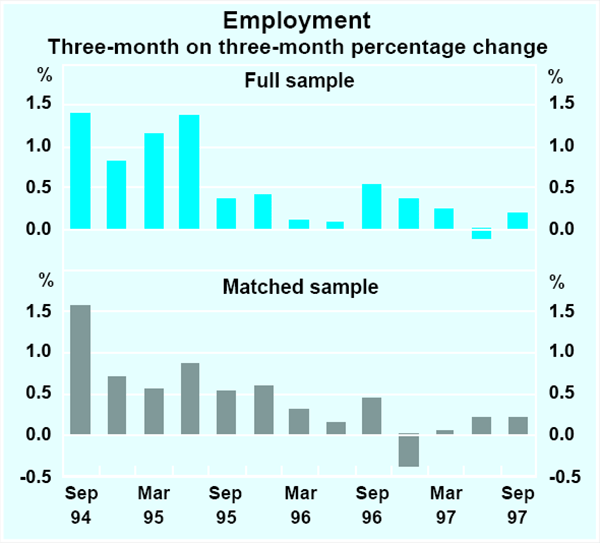
In addition to the cyclical behaviour of employment, which can best be explained by movements in aggregate demand such as the slowing in 1996, there are other longer-term influences on employment which are more subtle. Historically an important influence in Australia has been the interaction between real wages and productivity. While the behaviour of real wages in the 1990s has been nothing like the exceptional behaviour that occurred in the 1970s, real wages in the 1990s have nevertheless risen a good deal faster than in the 1980s.
The average increase in weekly ordinary-time earnings in the six-year period since the cyclical trough in output has been 3.3 per cent, compared with average growth of non-farm product prices of 1.7 per cent. This represents a cumulative increase in the real wage measured in terms of producer prices of around 10 per cent. This is in sharp contrast to the 1980s expansion when real wages were flat or falling (Graph 23). There are clearly a number of reasons for the differences in real-wage outcomes between the two cycles, including the role of the Accord in restraining real wages in the 1980s after a significant lift early in the decade, as well as the more rapid trend productivity growth in the 1990s. Nonetheless, other things equal, relatively rapid increases in real wages will tend to increase the pressure on businesses to downsize their workforces, leading to somewhat lower aggregate employment growth than would otherwise be the case. Compared to the 1980s, the current expansion has been characterised by stronger real wages and weaker average growth in employment.
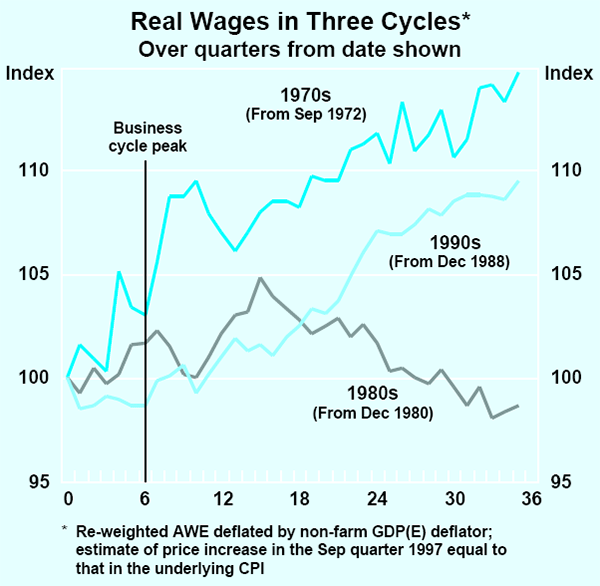
This pattern is also evident in international comparisons. In international terms, Australia's economic growth performance over the past five years has been good: average GDP growth in Australia and New Zealand has been higher than in any of the G7 countries over that period (Table 7). While Australia's average growth rate of employment of 1¾ per cent looks high by international standards, it is not high when compared to our rate of growth of output. The Australian economy has not been good at converting output growth into jobs growth. In the United States, employment growth has been nearly as high as Australia's, despite having significantly lower GDP growth, while New Zealand, with roughly the same growth in output as Australia, produced substantially higher employment growth. A corollary of these observations, of course, is that productivity growth in Australia has been higher. However, to the extent that productivity gains are induced by uncompetitive wage outcomes rather than structural improvements in efficiency, they do not expand the scope for sustainable growth in activity and employment.
| Real GDP | Employment | Real wages(a) | Working age population |
|
|---|---|---|---|---|
| United States | 2.6 | 1.5 | 0.9 | 1.0 |
| Japan | 1.4 | 0.4 | 0.8 | 0.1 |
| Germany | 1.4 | −0.9 | 1.4 | 0.2 |
| France | 1.2 | −0.2 | 1.0 | 0.3 |
| Italy | 1.0 | −0.9 | 0.0 | −0.1 |
| United Kingdom | 2.3 | 0.1 | 1.1 | 0.3 |
| Canada | 2.2 | 1.2 | 0.6 | 1.3 |
| Australia | 3.7 | 1.7 | 1.7 | 1.1 |
| New Zealand | 3.6 | 2.9 | 0.1 | 1.3 |
| (a) Wages, salaries and supplements per wage and salary earner, deflated by GDP deflator | ||||
The relatively rapid increases in real wages during the current expansion seem to have reflected overly ambitious expectations by wage setters as to the increases that could be sustained in a low-inflation environment. By mid 1997there were signs that this situation was changing. Labour markets appeared to be responding to continued low inflation and weak employment demand with a slackening in the pace of aggregate wages growth, particularly in the private sector. Real wages also levelled out after the earlier period of growth. As discussed in detail below, wage outcomes in the September quarter cast doubt on that assessment, showing a strong rebound in aggregate wages growth. If sustained, that could pose significant risks to employment prospects. Although, in the near term, the labour market will benefit from the stronger growth in the economy now under way, resumption of a strong upward trend in real wages would tend to cut short the prospects for more rapid employment growth in the longer term.
Financial Sector
The pace of financial intermediation has remained quite strong throughout the past two years. Annualised growth in the stock of credit provided by financial intermediaries to the private non-finance sector was 11.9 per cent in the six months to September 1997, up from 8.7 per cent in the previous six months. These rates of credit growth have remained well above the rate of increase in nominal GDP (Graph 24).
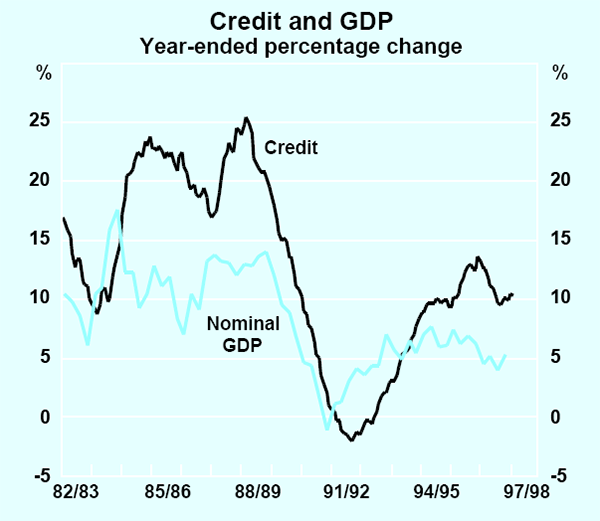
All three major types of credit have grown strongly (Table 8). Demand for housing finance has seen housing credit outstanding increase at about 11 per cent per annum, although this is well down on the rates of 20 per cent or more at the peak of the housing upswing in 1993 and 1994. Personal credit and business credit have both picked up over the past six months, particularly the latter.
| Six months to: | Three months to: | |||
|---|---|---|---|---|
| March 1997 | September 1997 | June 1997 | September 1997 | |
| Total credit | 8.7 | 11.9 | 11.7 | 12.1 |
| – Personal | 9.2 | 9.5 | 6.7 | 12.4 |
| – Housing | 10.5 | 11.0 | 12.8 | 9.2 |
| – Business | 7.3 | 13.4 | 11.9 | 15.0 |
| Currency | 2.8 | 9.0 | 12.1 | 6.0 |
| Broad money | 10.1 | 9.9 | 13.7 | 6.3 |
The community's gross holdings of monetary assets have increased in tandem with this expansion in credit. Broad money increased by 10 per cent over the year to September, about the same as in the preceding 12-month period. The more liquid part of the community's assets have increased more quickly, with M1 (mainly accounts with cheque facilities but low interest rates) increasing by almost 20 per cent over the past year. Demand for currency has also increased, with notes and coin in the hands of the public rising by almost 6 per cent over the past year, up from 3 per cent in the preceding year. This acceleration in narrow measures of money is quite a common pattern in periods where interest rates decline, as the opportunity cost (in terms of forgone interest)of holding cash and low-yield cheque accounts declines. The rapid growth in M1 may also reflect ongoing innovation, where cheque facilities are increasingly offered in accounts which also have the characteristics of savings vehicles. Holdings in cash management trusts have increased strongly as well, rising by more than 50 per cent over the year to September. Although rates on instruments such as bank bills (the main determinant of cash management trust yields) have fallen, the flattening of the yield curve over the past couple of years has lessened the attractiveness of two- and three- year fixed deposits relative to yields of cash management trusts. Overall, the community's gross holdings of liquid assets have increased noticeably during the period of declining interest rates.
The adjustment to lower interest rates can also be seen in increased flows of funds into some other classes of assets. In addition to rapid growth in cash management trusts, listed property trusts and equity trusts also recorded significantly higher growth over the year to June 1997 than in either of the preceding two 12-month periods (Table 9) although some of the increase in growth is likely to reflect rising asset values.
| June 1995 | June 1996 | June 1997 | |
|---|---|---|---|
| Cash management trusts | −4.9 | 25.1 | 52.3 |
| Unit trusts | 9.5 | 16.3 | 38.5 |
| of which: | |||
| – Property trusts | 11.7 | 14.4 | 22.7 |
| – Equity trusts | 14.1 | 19.7 | 50.2 |
| – Mortgage trusts | 0.5 | 24.4 | 42.6 |
| Life offices | 3.4 | 7.4 | 14.2 |
| Superannuation funds | 10.0 | 15.2 | 19.9 |
| Total | 6.2 | 11.9 | 20.5 |
|
Sources: ABS Cat. Nos 5655.0 and 5645.0 |
|||
These data pre-date the recent instability in share markets. It remains to be seen to what extent those events affect the size and composition of these flows. Up to now, however, these financial portfolio changes by the private sector have illustrated well a part of the ‘transmission mechanism’ of monetary policy, whereby declines in short-term interest rates, if brought about by a credible policy regime, boost asset markets, and provide an environment conducive to ongoing investment activity.
Intermediaries' interest rates
While developments in Asia, and beyond, dominated very recent developments in capital markets in Australia, the setting of monetary policy was the main influence on movements in intermediaries' interest rates – the interest rates most likely to influence households' and businesses' decisions to borrow and spend.
For the reasons explained earlier, monetary policy has been eased in two steps since the previous Semi-Annual Statement, with the target for the cash rate reduced by a total of 1 percentage point to 5 per cent. The monetary policy moves since July 1996 have reduced the cash rate by 2½ percentage points from 7½ per cent (Graph 25).
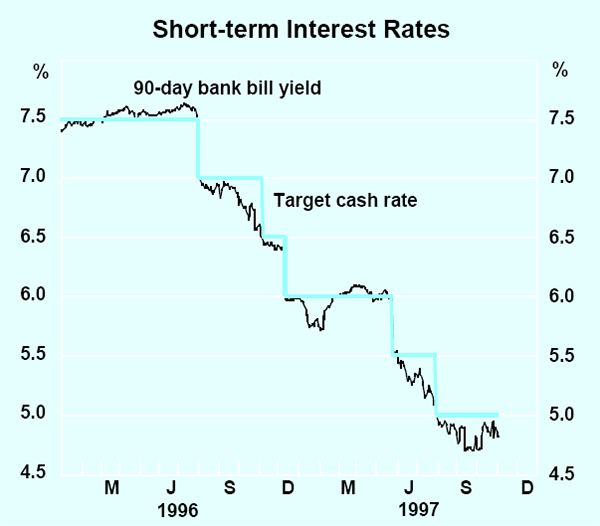
Banks have reduced their borrowing and lending rates as a result of the latest two monetary easings, although in some cases not to the full extent of the fall in cash rates. Even so, interest rates on offer to household and business borrowers are below levels at the previous cyclical low in 1993/94. Interest rates on housing loans are at their lowest level since 1970, while those for business loans are at their lowest since 1973 (Graph 26).
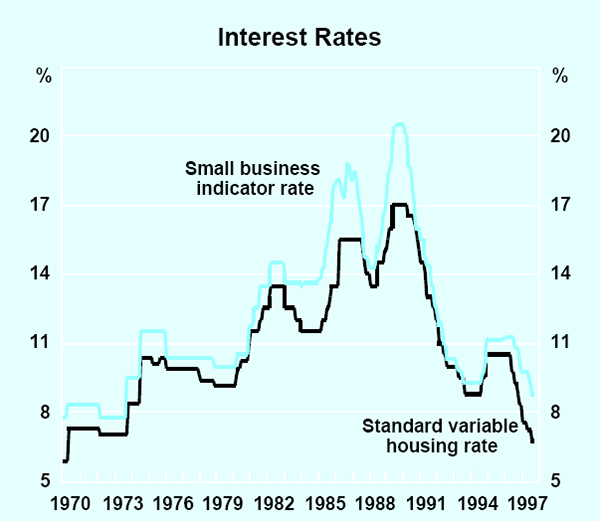
The predominant indicator rate on small business variable-rate loans has been cut by the full percentage point reduction in the cash rate since May, to a level of 8.75 per cent. This is now 0.55 of a percentage point below its level in 1993/94. The Reserve Bank's Small Business Finance Advisory Panel met in mid September and members reported that they were generally satisfied with levels of interest rates and the availability of finance from banks.[1]
For large businesses, reductions in bank lending rates have been slightly less than the fall in the cash rate. Since the May easing, the predominant indicator rate on variable-rate loans to large businesses has fallen by 0.85 of a percentage point to 8.45 per cent. Bank lending to large business is, however, concentrated in bill finance; bill yields have fallen in line with the cash rate.
For housing loans, taking the May and July easings together, most banks have reduced the interest rate on standard variable-rate loans by 0.85 of a percentage point, with the predominant rate now at 6.7 per cent. Since May 1996, when banks began the process of reducing the margin on the standard housing product to meet the fierce competition from mortgage managers, this rate has fallen by 3.8 percentage points, 1.3 percentage points more than the reduction in the cash rate.
In addition to the standard variable-rate product, banks generally offer a wide range of housing loans, including basic (or ‘no frills’) loans at variable interest rates as well as ‘honeymoon’ and fixed-rate loans. Interest rates on ‘honeymoon’ loans and basic loans have generally been cut by 0.75–0.85 of a percentage point since May, whereas rates on fixed-rate loans, which reflect funding costs in longer-term capital markets, have fallen by 1.1–1.3 percentage points.
As was explained in the Bank's ‘Quarterly Report on the Economy and Financial Markets’ published in the August Bulletin, most banks' decisions in May to reduce standard variable housing interest rates by less than the cash rate reflected several factors. One factor was the dynamics of the market for housing loans following the intense competition evident over the preceding year or more. Over that period, banks had cut housing interest rates by more than the cash rate had fallen. These additional reductions took banks' standard housing rates to around the level of rates charged by these institutions. As a result, banks had largely recovered their former market share by early in 1997, and therefore felt under less intense pressure to pass on to borrowers all of the May and July reductions in the cash rate. In the event, however, this action saw banks' market share fall away quickly again.
Another factor was that, while the cash rate is a reasonable guide to the cost of banks' funding in wholesale markets, their total cost of funds is also determined by costs of other sources of funds, such as for retail deposits. By May, interest rates paid on banks' retail deposits were already very low, leaving little room for them to fall further (Graph 27). The cost of retail funds was also held up by the delay in reducing interest rates paid on so-called deeming accounts – which reflect interest rates deemed by the Department of Social Security to be paid on pension recipients' bank accounts for taxation and welfare purposes. Deeming rates were not reduced until after the July easing, when they were cut by a percentage point, to 5 per cent on large deposits and 3 per cent on small deposits. In sum, the Bank estimates that banks' average cost of funds fell by a total 0.7 of a percentage point from the adjustment to deposit rates after the May and July easings, a result which is putting further downward pressure on banks' margins. Recent movements in banks' interest margins are set out in Box E.
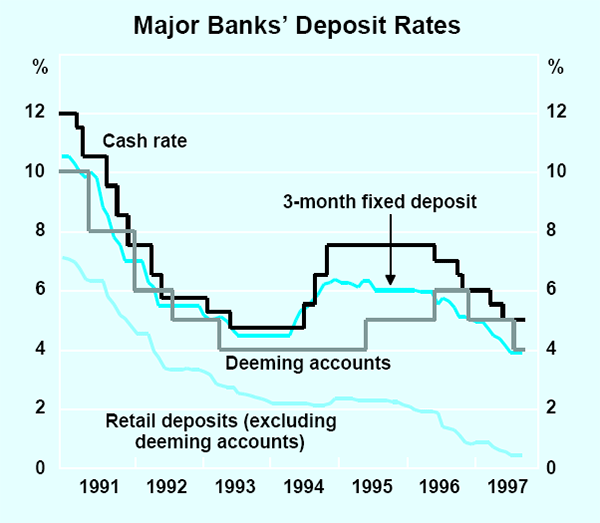
Box E: Banks' Interest Spreads
The Bank monitors movements in banks' interest rate spreads – i.e. the difference between the average interest rate received and the average interest rate paid – from a variety of information supplied by banks. The most comprehensive data are from banks' published financial statements, though these are at a very aggregated level and available only half-yearly, with a lag. The Bank also collects, on a quarterly basis, data on the average interest rate received on business loans, together with ongoing data on indicator lending rates. These provide more timely, though less comprehensive, information.
Graph E1 plots data on the average spread of the four major banks for the period up to the first half of 1997, the latest period for which annual report data are available. The overall spread has declined significantly during the period since deregulation, from 5.0 per cent in 1980 to about 3.4 per cent. Since the mid 1980s, the graph also plots the spread on performing assets. The gap between this and the overall spread reflects the impact of non-performing loans. This was most significant in the early 1990s, when the spread on performing loans rose a little while the overall spread declined. As bad loans ran off over 1993 and 1994, the overall spread recovered, and banks responded by reducing the spread on performing loans. With that period of adjustment over, a clear downward trend in both measures of the spread has resumed since 1994.
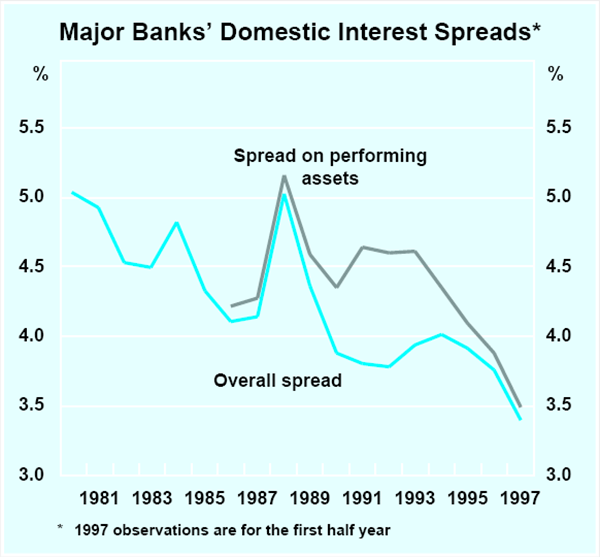
An indication of what factors have been driving the change in the spread can be gained by comparing its two components – the average interest rate received and the average interest rate paid – to the cash rate. Over the period since mid 1996, as monetary policy has been eased, the average interest rate received by banks has fallen broadly in line with the cash rate. As discussed below, however, this average masks a divergent pattern among different loan products. The average interest rate paid, in contrast, has fallen by considerably less than the cash rate – hence the reduction in overall spreads.
As can be seen in Graph E2, over a long run of years, the relationship between average rates of interest paid and received, on the one hand, and the cash rate, on the other, is only a loose one. In particular, the cycle in the average interest rates on loans and deposits is less pronounced than that in the cash rate. The cash rate only provides an indication of the rates paid by banks for wholesale deposits. It can be thought of as a measure of banks' marginal cost of funds. The greater stability in banks' average interest rates reflects two main factors: in addition to funds raised in wholesale markets, banks also offer retail deposits where interest rates do not vary much; and they also have a sizeable proportion of deposits and loans at fixed rates on which interest rates change only on roll-over, rather than when the cash rate changes.
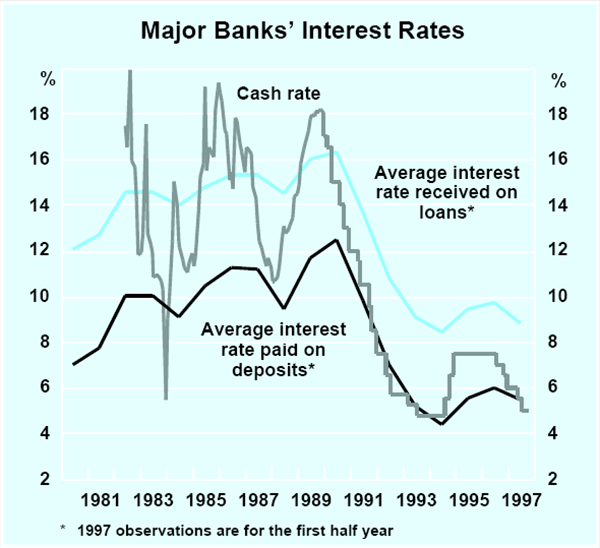
Margins on Loans
As noted, not all interest rates on loans have fallen in line with the cash rate: some have fallen by more and some by less. This is illustrated in Tables E1 and E2, which show the net change since the June quarter 1996, the period during which monetary policy has been eased, in a variety of indicator lending rates and, where available, the change in the average overall interest rates paid.
Variable-rate loans
Table E1 shows movements in interest rates on various types of variable-rate loans. The points to note from the table are as follows:
| Movement between June quarter 1996 and September quarter 1997 Percentage points |
|
|---|---|
| Housing | |
| Standard variable | −3.8 |
| Basic | −2.8 |
| Honeymoon | −2.0 |
| Small business | |
| Indicator rates | |
| – Overdrafts | −2.5 |
| – Residential-secured overdraft | −4.7 |
| – Term loans | −2.6 |
| Average overall rate(a) | −3.1(b) |
| Large business | |
| Indicator rates | |
| – Overdrafts | −2.3 |
| – Term loans | −2.6 |
| Average overall rate(a) | −2.7(b) |
| Cash rate | −2.5 |
| (a) Includes customer risk margin (b) Figures for the average overall rate are based on the four major banks, using preliminary data for the September quarter 1997 |
|
- The standard variable housing rate loan has fallen by 3.8 percentage points over the period, which is 1.3 percentage points more than the fall in the cash rate, implying a sharp contraction in margins; this is also evident, though to a lesser extent, for basic housing loans. This reflects the increase in competition in the housing loan market, spurred on by the growth of mortgage managers. Against this, rates on honeymoon loans have fallen by less than the cash rate, as banks have pulled back from these types of loans.
- The indicator rates on small business overdrafts and term loans have fallen broadly in line with the cash rate, consistent with these margins remaining steady. However, as the interest rate on term loans is lower than for overdrafts, there has been some shift out of overdrafts into term loans. Banks have also introduced new products such as overdrafts and term loans secured by equity in residential property. The rate on residential-secured overdrafts has fallen by over 2 percentage points more than the cash rate, as banks have come to recognise more explicitly the quality of security supporting business loans. As a result of the growing popularity of these new products, average interest received across all variable-rate small business loans has fallen by about 3 percentage points since mid 1996. This is larger than the fall in the cash rate, though this trend has only become apparent in the latest preliminary figures for the September quarter 1997.
- In the case of large business loans, the indicator rate for overdrafts has fallen by slightly less than the cash rate while the indicator rate for term loans has fallen by a little more. Overall, the preliminary figures for the September quarter 1997 suggest that the overall interest rate on loans to large businesses has fallen by slightly more than the cash rate since mid 1996.
Bills
Interest rates on bill lines have moved in line with the cash rate, as they are priced directly off yields in the money market.
Fixed-rate loans
Interest rates on fixed-rate loans are priced off capital market interest rates of relevant maturities, rather than the cash rate. Table E2 shows movements for 3-year fixed-rate loans and the movement in their funding cost, proxied by the 3-year rate in swap markets. For small and large business loans, the change in the average interest rate received on all existing fixed-rate loans outstanding is also shown.
| Movement between June quarter 1996 and September quarter 1997 Percentage points |
|
|---|---|
| Housing | |
| New loans | −2.5 |
| Small business | |
| Indicator rate on new loans | −2.9 |
| Average rate on all existing loans | −1.2(a) |
| Large business | |
| Indicator rate on new loans | −3.0 |
| Average rate on all existing loans | −1.2(a) |
| Three-year swap rate(b) | −2.9 |
| (a) Figures for the average overall rate are based on the four major banks,
using preliminary data for the September quarter 1997; they include customer
risk margin (b) 3-year swap rate is used as indicative funding rate |
|
Indicator rates have fallen broadly in line with the swap rate since mid 1996. However, the average interest rate received on all existing business fixed-rate loans has fallen by less than the swap rate. The smaller fall in the overall interest rate received than in the indicator rates for new loans reflects the fact that the latter have not yet worked their way through the stock of existing loans. Of course, on the deposit side, banks would be experiencing a corresponding phenomenon – i.e. the average cost at which existing fixed-rate loans are being funded has not yet fully reflected the recent falls in interest rates. As noted earlier, during periods of falling interest rates, these adjustment lags work to hold up both the average interest rate received and the average interest rate paid; during periods of rising interest rates, they work in the opposite direction.
End Piece
In summary, banks' interest margins have narrowed over the past 18 months or so as monetary policy has been eased. Their overall deposit costs have not fallen in line with the cash rate, due importantly to the limited scope to further reduce retail deposit interest rates. At the same time, competition has nonetheless forced loan rates lower. This competition was first evident in the housing loan market, particularly from mid 1996 reflecting the expansion of mortgage managers into this market. It has now started to flow through into small business loan rates, as reduced housing margins have forced banks to look to increase market share in other areas. This process has resulted in banks introducing a range of new small business products offering discounted interest rates and better reflecting the type of security being offered. Until recently, the effects of this competition in small business finance were not evident in banks' aggregate figures on interest received, suggesting that the switch to lower priced products was only gradual. But the latest numbers from the major banks, which remain preliminary, are starting to show a more significant impact.
This competition should continue, though it is unlikely that margins on small business loans will fall to the same level as those on housing, due both to the higher risk on small business lending and to the greater difficulty new lenders are likely to face in contesting this market.
In response to the two cuts in cash rates since May, banks, on average, took about as long to reduce their interest rates on particular products as with the three previous easings in the second half of 1996; this is longer than it took banks to raise rates during the tightening phase of 1994. For housing loans, the average lag in passing on the cuts in cash rates has been over seven weeks; for small business, about five weeks. In both cases in 1994, the lag in raising rates was a little over two weeks (Table 10).
| Easings 1990–93 | Tightenings 1994 | Easings 1996–97 | |
|---|---|---|---|
| Small business indicator rate | 23 | 16 | 35 |
| Large business indicator rate | 18 | 16 | 21 |
| Housing indicator rate | 32 | 16 | 51 |
Inflation Trends and Prospects
Recent developments in inflation
Consumer prices in underlying terms rose by 0.3 per cent in the September quarter and by 1.5 per cent over the year (Graph 28). On a year-ended basis the underlying inflation rate has fallen steadily from its most recent peak of 3.3 per cent, reached in the March quarter of 1996.
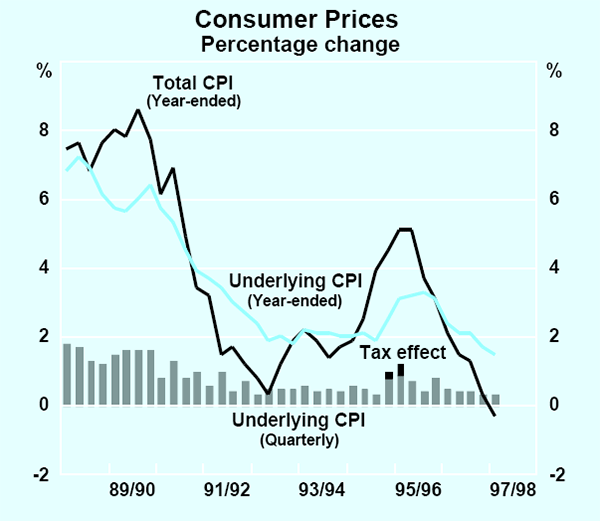
The headline CPI continues to be affected by recent interest rate reductions which have held the headline inflation rate considerably below other measures. The September quarter figure was also reduced by the effect of rebates for health insurance introduced on 1 July, which are recorded as a reduction in the cost of premiums. Reflecting these factors, the headline CPI declined in the September quarter by 0.4 per cent, and by 0.3 per cent over the year. Mortgage interest rate reductions have detracted 1¾ percentage points from the movement in the CPI over the past year.
Falling import prices have for some time been contributing to the subdued underlying inflation results (Graph 29). This remained the case in the September quarter. The imported goods component of the CPI declined by 0.5 per cent in the quarter and by 1.5 per cent over the year. The continuing declines in retail import prices reflect the gradual pass-through of the effects of earlier appreciation of the trade-weighted exchange rate, much of which took place over 1996. This effect can be expected to fade as the pass-through becomes more complete. The trade-weighted exchange rate has shown little further net movement over the past year, rising in the early part of this year before returning to around the levels of late 1996 in the middle part, then falling over recent weeks. Given the typically gradual nature of the pass-through into final prices, these shorter-term movements in the exchange rate over the past year are likely to have only relatively small effects on retail prices of imported goods in the period ahead.
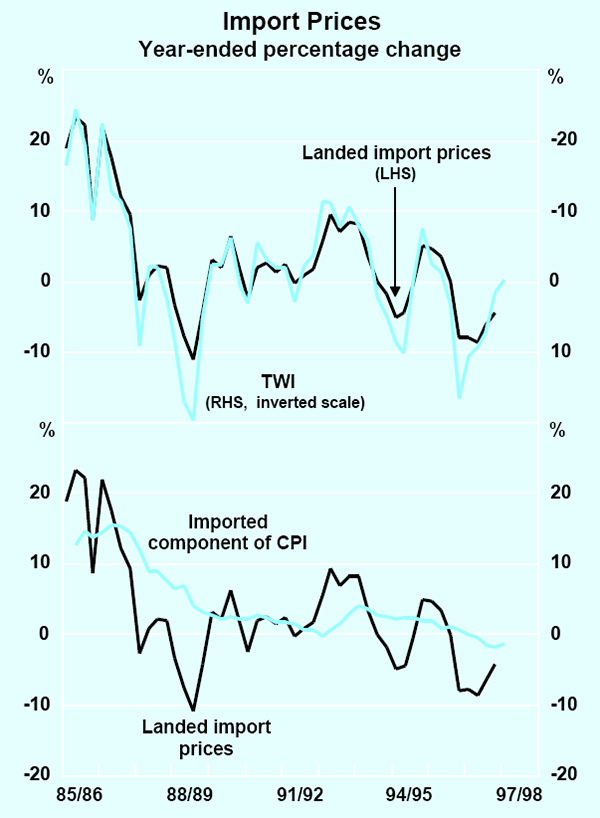
Prices of domestically produced consumer goods have also been more subdued recently. They fell slightly in the September quarter and rose by 1.8 per cent over the year to September, continuing the general trend of deceleration evident in recent quarters (Graph 30). Strong competition from imported goods is likely to have contributed to this trend. In contrast, private-sector service price increases have picked up recently to be running at 3.6 per cent over the latest year.

Producer prices have for much of the past two years shown less tendency to rise than underlying consumer prices. Over the year to December 1996, manufactured output prices increased by only 0.2 per cent, while building materials prices were similarly flat. More recently producer prices have been somewhat firmer, probably reflecting the stronger demand conditions in 1997, although their rate of increase to date remains moderate. Manufactured goods prices increased by 0.5 per cent in the September quarter and by 1.6 per cent over the year, while housing and non-residential building materials prices rose by 1.5 and 1.2 per cent respectively over the year (Graph 31). Imported input prices showed a sharper pick-up in the September quarter, reflecting the recent exchange rate movements, but this followed substantial falls over the previous two years.
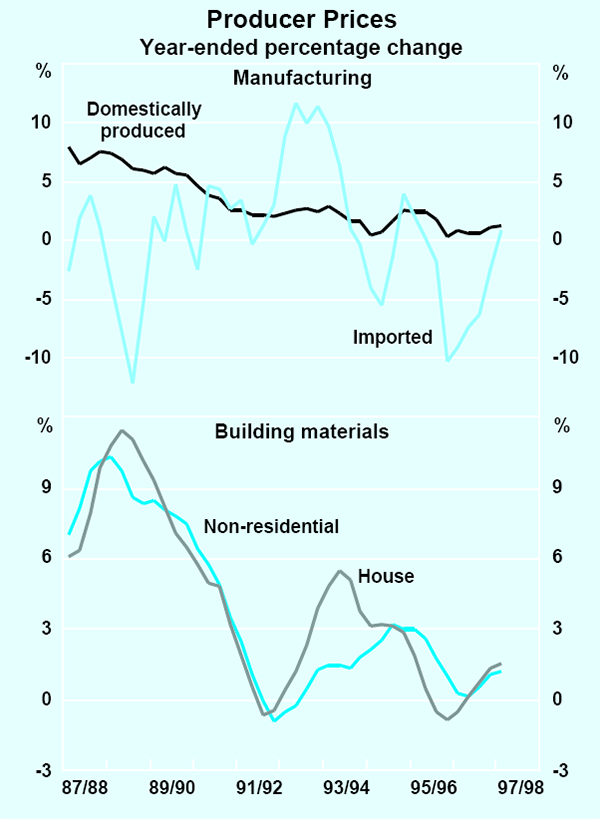
Trends in labour costs
Recent developments in wages continue to be difficult to interpret. There have for some time been divergent trends between measures of private and public-sector wages, and to a lesser extent between aggregate wage measures and more specialised indicators of bargaining outcomes. The picture has been further complicated by large fluctuations in the estimates of aggregate wages growth in the two latest quarters.
All measures of average earnings compiled in the Average Weekly Earnings survey showed a sharp jump in the three months to August. Average weekly ordinary-time earnings (AWOTE), the measure which should be least affected by changes in average hours worked and compositional changes, increased by 1.6 per cent in the quarter. This followed a rise of 0.3 per cent in the previous three months (Graph 32). The other measures showed a broadly similar pattern. Taking the results at face value, and averaging the increases in AWOTE over the two quarters, they suggest that aggregate wages have continued to rise at around one per cent per quarter, about the same pace that has been evident for the past two years. Over the year to August they increased by 4.1 per cent. Flow-through of the recent safety-net decision will have contributed to the August outcome although the effect is relatively small.
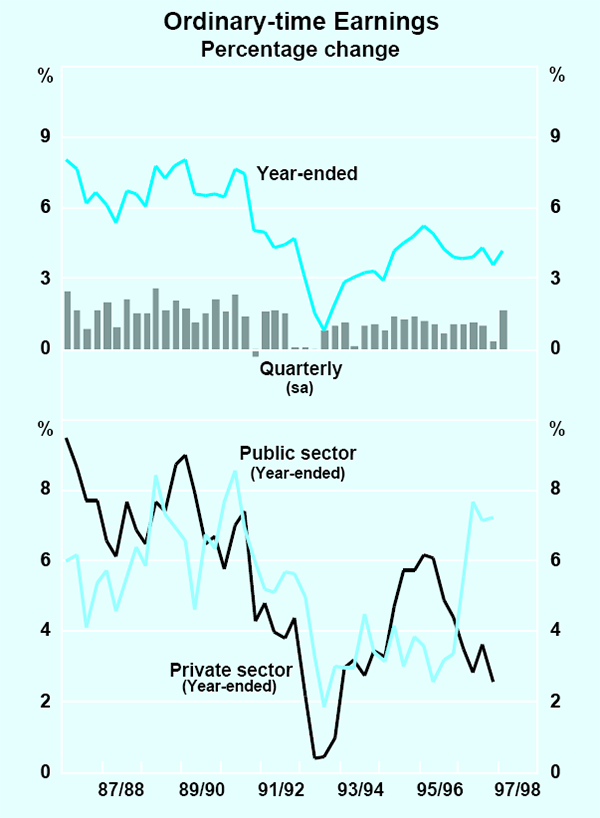
Notwithstanding the flat trend in aggregate AWOTE growth, there has, at least until recently, been a decline in growth of the private sector component, offset by unusually high outcomes in the public sector. Over the year to May (the latest period for which data are available at the disaggregated level) public-sector AWOTE increased by 7.2 per cent. This figure remains well above the increases applying under currently active enterprise agreements in the public sector, and seems likely to reflect compositional changes in the public-sector workforce associated with ongoing restructuring. The increase in private-sector AWOTE over the year to May was 2.5 per cent, having declined substantially from the peak of over 6 per cent reached in 1995.
While the recent figures are difficult to interpret, it seems clear that this trend decline in private-sector wage growth has now come to an end, and that the figure for the year to May overstates the extent of the trend decline. If the aggregate wage outcomes for the three months to August are at all representative for the private sector, they imply a significant rebound in that sector's annual wage growth; what is not yet clear is its extent. For the sake of illustration, applying the aggregate quarterly increase in the three months to August equally to both sectors would imply a rise in annual private-sector earnings growth to around 3½ per cent. These results must be considered disappointing in an environment where underlying consumer price inflation is running at 1½ per cent, producer price increases are running at a similar rate, and demand for labour has been flat.
Wage increases negotiated under enterprise agreements have continued to yield increases of around 5 per cent on average, about the same rate that has prevailed for the past year (Graph 33). While there has been no general tendency for these increases to ease in the face of lower inflation and the weaker labour market, there is some evidence of increasing diversity of outcomes in response to differing conditions across industries. Wage pressures have been relatively strong in the construction sector, where skill shortages have emerged in line with strengthening activity. Construction agreements reported annualised increases of 6.1 per cent in the June quarter. These pressures appear to have continued in the second half of the year. In contrast, wage outcomes in the metals and finance industries have eased a little during the past year, although they remain high.
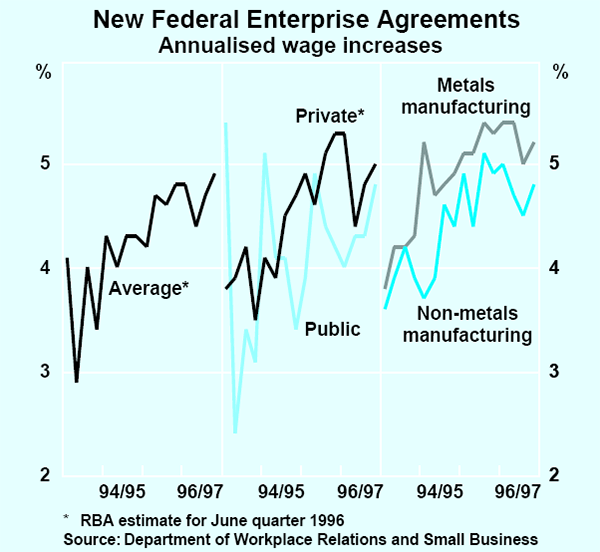
Growth of executive salaries, as reported in the Cullen, Egan and Dell survey, remains stubbornly high at around 6 per cent, little changed from the rates of increase that have been reported for the past two years. These increases seem increasingly unrelated to trends in business conditions, particularly given the weakness of selling prices over the past year and the pronounced slowing of profit growth.
Award wages are now feeling the effect of the flow-through of the recent safety-net decision, which increased awards by $10 a week, equivalent to around 1¾ per cent for workers on average award wages. Much of this increase is likely to have been paid in the September quarter. The ACTU has now foreshadowed an additional claim, which is likely to be heard early next year. The claim seeks in its initial stage to increase all award wages by a flat dollar amount of $20.60 a week, which represents a 5.7 per cent increase for those on the minimum award but a smaller proportionate rise for those on higher awards. The claim also contains a second stage which aims for an additional $38 increase in the subsequent year.
Inflation expectations
On most measures inflation expectations are close to historic lows, having declined substantially in the early part of the 1990s and generally undergoing a further downward shift in the past year. The general pattern has been that expectations have tended to follow trends in actual inflation with a lag, and, as a track record of low inflation has been built up during the 1990s, this has been increasingly taken into the public's expectations. Recognition of the low inflation environment may have been reinforced by the fact that the most recent period of rising inflation, in 1994/95, was successfully resisted and that inflation has subsequently fallen. On some indicators, however, expectations of inflation remain higher than actual rates, and higher than the target.
Consumers' inflation expectations, as measured by the Melbourne Institute's monthly survey, moved down in late 1996 and have subsequently remained at around their new lower level (Graph 34). The October survey reported an expected inflation rate of 3.4 per cent, representing the average expected increase in the Consumer Price Index over the year ahead. Results for this survey during the past year have generally fluctuated in the 3 to 3½ per cent range, around a percentage point lower than the average that had prevailed over the previous couple of years.

Medium-term inflation expectations of business respondents have shown quite a similar pattern to the results of the consumer survey. The NAB Survey recorded a sizeable downward shift in medium-term inflation expectations during 1996, but little further change over the past year. Like consumers, business respondents typically expect inflation to be slightly above the target, with the most common response being in the 3 to 4 per cent range.
Near-term price expectations of producers have remained low in recent months and seem to show little impact from the current strengthening in demand conditions. In this sense they give a somewhat more subdued picture of price pressures than the recent results for producer price increases discussed above. According to the NAB business survey, retailers expect to increase their selling prices by 0.5 per cent in the December quarter, following average quarterly increases of 0.4 per cent according to the same survey in the first three quarters of the year. Manufacturers have generally held weaker price expectations than other industries for some time. The latest ACCI-Westpac survey of manufacturing businesses, taken in September/October, suggests flat prices, with roughly equal numbers of businesses expecting prices to rise as to fall in the December quarter.
Expectations of financial market participants, as indicated both by surveys and by market-based indicators, have been declining during the past year. In contrast to business and consumer survey results, they are also at levels consistent with the inflation target. A long-term market based indicator, the indexed bond yield differential, currently implies an expected average inflation rate over the next ten years of around 2 per cent. This indicator has been declining steadily for some time, in line with nominal bond yields, and is about a percentage point below the levels that were typical a year ago. A survey of financial market participants conducted by the Bank points to continued downward revisions of their near-term inflation forecasts over the past year. Economists surveyed immediately after the September quarter CPI release returned a median forecast of 1.9 per cent for underlying inflation over the year to June 1998, having been forecasting a 2.9 per cent underlying rate a year earlier (Table 11).
| Year to June 1998 per cent | Year to June 1999 per cent | ||
|---|---|---|---|
| October 1996 survey | October 1997 survey | October 1997 survey | |
| Underlying | 2.9 | 1.9 | 2.6 |
| Headline | 3.0 | 0.8 | 3.2 |
Inflation outlook
In the near term, the climate remains favourable to a continuation of the low rates of inflation seen over the past year. Notwithstanding the pick-up in growth that is currently under way, the economy still has ample capacity to satisfy expanding demand, and price expectations are generally low. At its current rate of growth, the economy is likely to be absorbing surplus capacity at only a moderate pace which would not generate the sorts of bottlenecks that accompanied the very rapid phase of the current expansion in 1994/95. Producers and retailers still report that they expect only very modest price increases in the December quarter.
Given these circumstances the prospects are that inflation will remain below 2 per cent in the near future. Looking further ahead, however, there are signs that the trend reduction in inflation, which has reduced the underlying rate from over 3 per cent to 1½ per cent over the past two years, may be close to having run its course. The inflation reduction has resulted from three main factors: a significant slowing in the rate of growth of demand and output, particularly in 1996; appreciation of the trade-weighted exchange rate, which rose by nearly 10 per cent over the same year; and a decline in growth of average wages, particularly in the private sector, over a two-year period running to around the middle of 1997. Prospects in all three areas are for a smaller restraining impact on domestic prices in the period ahead.
As discussed above, the path of the exchange rate has exerted an important influence on recent inflationary trends. To date, the main impact has come from the sharp appreciation that occurred during 1996. The pass-through of these effects to retail prices has been sufficiently gradual that the contribution of imported goods prices to the CPI by the September quarter 1997 was still negative, and there may be some further price reductions still to flow through. Nonetheless the overall effects of Australia's earlier currency appreciation will soon fade or begin to be offset by more recent, although smaller, movements in the other direction. In net terms the contribution of import prices to underlying inflation can be expected to shift from a negative to a broadly neutral position over the year ahead.
The restraining influence from domestic demand conditions evident over the past couple of years is also likely to become weaker. The economy is now growing at or close to trend after a period of slower growth that undoubtedly contributed to restraint of domestic prices. With monetary policy now in an expansionary setting, a continuation of the current stronger growth is in prospect. That in turn will mean that the cyclical forces that helped to bring the inflation rate below the target will, over time, be lessened.
With temporary exchange rate effects and cyclical factors having less of an influence, recorded rates of inflation can be expected to be a little higher over the year ahead as longer-term domestic forces reassert themselves. After a period of below 2 per cent inflation, the inflation rate is expected to move back within the 2–3 per cent range, probably towards the end of 1998.
An important determinant of the trend in inflation will be the extent of any pick-up in domestic labour costs. In this regard recent developments have been less encouraging than had appeared likely a few months ago. The strong figure for earnings growth in the September quarter, while most likely an overstatement of ongoing wages growth, does suggest that the downward trend in private-sector wages growth has probably come to an end. On the latest reading, which is subject to considerable uncertainty, private wages appear to be growing at an annual rate of around 3½ per cent, and economy-wide wages at around 4 per cent. Wage increases at around these levels would appear consistent with the inflation target although, as noted earlier, the implied rate of increase in real wages is likely to be unhelpful to prospects for employment growth.
Footnote
The Bank has separately provided the House of Representatives Standing Committee on Financial Institutions and Public Administration responses to their enquiries about aspects of small business financing. These notes were published in the Bank's Bulletin of October 1997. [1]
Footnotes Box B
Results in Graph B1 are derived using average household disposable income, which is the national accounts measure excluding imputed rent on owner-occupied dwellings divided by the number of households in Australia, taken from Census data. [1]
Footnotes Box C
See the May 1997 Statement for discussion of labour and total-factor productivity and their measurement. [1]
The revisions to the national accounts reflect changes in the measurement of output in several service-sector industries, the inclusion of businesses previously omitted from the ABS Business Register, and re-benchmarking of components of output. [2]
Footnotes Box D
The adjustments made here are done at a high level of aggregation and more complicated approaches are possible. [1]
Seasonal adjustment and constant-addition are performed separately for respondents in full-time and part-time work, and the results are then aggregated. [2]